My most current blog entry:
Winter Vacation 2013/14, Part Two: Rothenburg ob der Tauber
 Sunday, January 5, 2014 at 11:41PM
Sunday, January 5, 2014 at 11:41PM  The medieval town of Rothenburg ob der Tauber, in central Germany, was founded around 950. Today it is one of only a few intact walled medieval cities left in Europe. (This image was borrowed from Turistmus Rothenburg.) It is also known as "the best place in the world to spend Christmas." So, we went there for Christmas.
The medieval town of Rothenburg ob der Tauber, in central Germany, was founded around 950. Today it is one of only a few intact walled medieval cities left in Europe. (This image was borrowed from Turistmus Rothenburg.) It is also known as "the best place in the world to spend Christmas." So, we went there for Christmas.
 Our train pulled into Rothenburg on the afternoon of Christmas Eve. The Hotel Eisenhut was a fabulous Old World experience right in the center of this charming town. We checked in at the beautiful lobby, then offloaded our baggage in our spacious room and went out to look around before it got dark . . . and the shops closed.
Our train pulled into Rothenburg on the afternoon of Christmas Eve. The Hotel Eisenhut was a fabulous Old World experience right in the center of this charming town. We checked in at the beautiful lobby, then offloaded our baggage in our spacious room and went out to look around before it got dark . . . and the shops closed.
 Our hotel was next door to the "World Famous Christmas Museum" (Kathe Wohlfahrt) which had a wonderful old bus parked outside.
Our hotel was next door to the "World Famous Christmas Museum" (Kathe Wohlfahrt) which had a wonderful old bus parked outside.
 It was getting to be late afternoon, making photography in the dark shadowed narrow streets very difficult.
It was getting to be late afternoon, making photography in the dark shadowed narrow streets very difficult.
 Rothenburg is carefully and loving restored and maintained to the original medieval condition.
Rothenburg is carefully and loving restored and maintained to the original medieval condition.
 It was a beautiful (and mild) afternoon to walk around this historic and architectural gem.
It was a beautiful (and mild) afternoon to walk around this historic and architectural gem.
 Cobbled streets and pastel colors.
Cobbled streets and pastel colors.
 Lots and lots of cobbled streets!
Lots and lots of cobbled streets!
 Rothenburg has the fine St. James Church from 1311.
Rothenburg has the fine St. James Church from 1311.
 The St. James Church holds an altar carved by the great German sculptor, Tilman Riemenschneider.
The St. James Church holds an altar carved by the great German sculptor, Tilman Riemenschneider.
 All over Germany people eat sneeballen ("snow balls") during the Christmas season. They look delicious, but are, in fact, somewhat dry . . . unless you get the amaretto and almond coated ones.
All over Germany people eat sneeballen ("snow balls") during the Christmas season. They look delicious, but are, in fact, somewhat dry . . . unless you get the amaretto and almond coated ones.
 It was beautiful no matter which way you turned.
It was beautiful no matter which way you turned.
 We walked around in amazement, but before too long we realized that almost all of the shops were closed! No Shopping! Oh No, it was Christmas Eve and everybody was home with their families.
We walked around in amazement, but before too long we realized that almost all of the shops were closed! No Shopping! Oh No, it was Christmas Eve and everybody was home with their families.
 All we could do was window shop.
All we could do was window shop.
 There were many things we wanted to purchase from the beautiful shop window displays. Drat!
There were many things we wanted to purchase from the beautiful shop window displays. Drat!
 Here and there we would head up a street to find the old arched gateway of the city wall.
Here and there we would head up a street to find the old arched gateway of the city wall.
 It felt like we had gone back in time . . . except for the occasional car.
It felt like we had gone back in time . . . except for the occasional car.
 The City Hall and City Museum were under restoration . . .
The City Hall and City Museum were under restoration . . .
 The old building exteriors were amazing, and so were the interiors! We loved looking into each shop window and marveling at what we were seeing. Bread!
The old building exteriors were amazing, and so were the interiors! We loved looking into each shop window and marveling at what we were seeing. Bread!
 So many beautiful shops . . . and shop window displays.
So many beautiful shops . . . and shop window displays.
 We were desperate to buy a set of these small ceramic Rothenburg town buildings to add to our collection from Prague, but the shops closed early on the 24th of December and did not open until after we left. Oh No!
We were desperate to buy a set of these small ceramic Rothenburg town buildings to add to our collection from Prague, but the shops closed early on the 24th of December and did not open until after we left. Oh No!
 We need doyleys and lace around our new Scottish home, but, alas, it was closed too.
We need doyleys and lace around our new Scottish home, but, alas, it was closed too.
 However, shops selling food were generally open on the 24th and 26th.
However, shops selling food were generally open on the 24th and 26th.
 Beautiful German breads!
Beautiful German breads!
 The sausage shop was closed. We could have filled our suitcases with these.
The sausage shop was closed. We could have filled our suitcases with these.
 Fortunately the butcher was open and had these cute pepperonis with cigar bands in a wood box. We bought a couple of boxes . . . they are great!
Fortunately the butcher was open and had these cute pepperonis with cigar bands in a wood box. We bought a couple of boxes . . . they are great!
 A Rothenburg doll shop. I always find great collections of dolls creepy . . . its the animist in me.
A Rothenburg doll shop. I always find great collections of dolls creepy . . . its the animist in me.
 We never tired of strolling arm in arm around this gem of a town.
We never tired of strolling arm in arm around this gem of a town.
 While walking around the narrow medieval street that Rothenburg, it's easy to forget that it is a walled hill town.
While walking around the narrow medieval street that Rothenburg, it's easy to forget that it is a walled hill town.
 Every once in a while our wanderings would spill us out at a view point over quaint river valley village scenes.
Every once in a while our wanderings would spill us out at a view point over quaint river valley village scenes.
 There was always something interesting to catch your eye, like this two-tailed merman.
There was always something interesting to catch your eye, like this two-tailed merman.
 It was cold, grey, and cloudy, but it was still like being in a post card.
It was cold, grey, and cloudy, but it was still like being in a post card.
 We walked around Rothenburg all day, but eventually had to get back to the rococo hotel to get ready for Christmas Eve dinner. Our hotel was filled with these wonderful old religious artifacts.
We walked around Rothenburg all day, but eventually had to get back to the rococo hotel to get ready for Christmas Eve dinner. Our hotel was filled with these wonderful old religious artifacts.
 Christmas Eve dinner was a special event at the Hotel Eisenhut Hotel: a three hour, nine course meal that culminated with this delicious fruit sorbet.
Christmas Eve dinner was a special event at the Hotel Eisenhut Hotel: a three hour, nine course meal that culminated with this delicious fruit sorbet.
 After dinner we went for a stroll in the brightly lit streets. This is our hotel on the right; the Hotel Eisenhut.
After dinner we went for a stroll in the brightly lit streets. This is our hotel on the right; the Hotel Eisenhut.
 The World Famous Christmas Museum.
The World Famous Christmas Museum.
 I woke up early and walked around the corner to fetch breakfast. Fortunately I brought my new Fuji X-E1 camera. What an amazing sight.
I woke up early and walked around the corner to fetch breakfast. Fortunately I brought my new Fuji X-E1 camera. What an amazing sight.
 Take-away coffee, cheesecake and strudel back at the hotel room. Delicious.
Take-away coffee, cheesecake and strudel back at the hotel room. Delicious.
 The following morning (Dec. 26) broke cold, wet, and gloomy. We decided to walk the length of the covered ramparts of the old city wall. There was much to see on the way, as usual.
The following morning (Dec. 26) broke cold, wet, and gloomy. We decided to walk the length of the covered ramparts of the old city wall. There was much to see on the way, as usual.
 Now THIS is what I call 'an addition' to your house!
Now THIS is what I call 'an addition' to your house!
 We first walked to the edge of town past these amazing vine covered homes. They would be just as wonderful in summer.
We first walked to the edge of town past these amazing vine covered homes. They would be just as wonderful in summer.
 As is my habit, I was infatuated by old doors showing their age. What is in there?
As is my habit, I was infatuated by old doors showing their age. What is in there?
 Yes, at some point, the neo-classical style even penetrated this old German village.
Yes, at some point, the neo-classical style even penetrated this old German village.
 Grand, heroic, and romantic . . . and pigeonproofed.
Grand, heroic, and romantic . . . and pigeonproofed.
 One of the newer buildings in Rothenburg from 1681. Only 335 years old.
One of the newer buildings in Rothenburg from 1681. Only 335 years old.
 An old door again; this time one of the city gates leading outside the town to a small garden and chapel. The textures visable in this flat light were wonderful.
An old door again; this time one of the city gates leading outside the town to a small garden and chapel. The textures visable in this flat light were wonderful.
 The small austere chapel was a little gem in the winter gloom.
The small austere chapel was a little gem in the winter gloom.
 The rain started to get heavier at this point, so we headed back under the gate we came from and discovered this wonderful view of medieval Rothenburg.
The rain started to get heavier at this point, so we headed back under the gate we came from and discovered this wonderful view of medieval Rothenburg.
 I couldn't resist taking more photos of this gate and wall. I am sure you could produce a fascinating book of photographs of just this gate alone.
I couldn't resist taking more photos of this gate and wall. I am sure you could produce a fascinating book of photographs of just this gate alone.
 "If these gates could talk" . . . . .
"If these gates could talk" . . . . .
 The other tourists began to immerge from their hotels to begin their silent meander through the streets of Rothenburf ob der Tauber.
The other tourists began to immerge from their hotels to begin their silent meander through the streets of Rothenburf ob der Tauber.
 So much to see in Rothenburg.
So much to see in Rothenburg.
 Rothenburg was especially beautiful in the rain.
Rothenburg was especially beautiful in the rain.
 Wet cobblestones evoke a kind of melancholia . . .
Wet cobblestones evoke a kind of melancholia . . .
 We followed the wall around to find the steps up to the ramparts. Nope, these would not take us where we wanted to go.
We followed the wall around to find the steps up to the ramparts. Nope, these would not take us where we wanted to go.
 Our route led us to an amazing door. I could not tell if this was contemporary or some kind of an old world attempt at 'modern' iron and rivet door-making. It looked like a lot of doors I have seen in India.
Our route led us to an amazing door. I could not tell if this was contemporary or some kind of an old world attempt at 'modern' iron and rivet door-making. It looked like a lot of doors I have seen in India.
 A retrofit? There was so much to look at and contemplate in Rothenburg.
A retrofit? There was so much to look at and contemplate in Rothenburg.
 A cat in an old Rothenburg window on a cold and dank winter day.
A cat in an old Rothenburg window on a cold and dank winter day.
 More old weathered doors than I knew what to do with . . . but fortunately I had a lot of storage media!
More old weathered doors than I knew what to do with . . . but fortunately I had a lot of storage media!
 We eventually found the way to the top of the city walls.
We eventually found the way to the top of the city walls.
 Up we went for a walk around the top of the city wall.
Up we went for a walk around the top of the city wall.
 There was some beautiful cantilever stonework on the city wall stairs.
There was some beautiful cantilever stonework on the city wall stairs.
 Walking the covered ramparts of the old city walls turned out to be the best thing to do on a rainy day.
Walking the covered ramparts of the old city walls turned out to be the best thing to do on a rainy day.
 The views from the ramparts were spectacular. It was fun to walk along these old passageways above the town.
The views from the ramparts were spectacular. It was fun to walk along these old passageways above the town.
 This foreign tourist seemed very happy to be where he was.
This foreign tourist seemed very happy to be where he was.
 There were some good opportunities to photograph patterns from the top of the city walls. We walked about 3/4 of the way around the city walls before coming down. It was getting late. Time to head back to the hotel.
There were some good opportunities to photograph patterns from the top of the city walls. We walked about 3/4 of the way around the city walls before coming down. It was getting late. Time to head back to the hotel.
 We walked back through one of the city gates to find Rothenburg lit up like a scene on a Christmas card.
We walked back through one of the city gates to find Rothenburg lit up like a scene on a Christmas card.
 We walked home in the gathering darkness as a few shops lit up the street. We went in this bakery and had coffee.
We walked home in the gathering darkness as a few shops lit up the street. We went in this bakery and had coffee.
 Hmmm . . . what do we want this time? . . . .
Hmmm . . . what do we want this time? . . . .
 We changed and walked a block to this Gasthof for another wonderful meal.
We changed and walked a block to this Gasthof for another wonderful meal.
 There was a manger in the churchyard. It was Christmas, after all.
There was a manger in the churchyard. It was Christmas, after all.
 We walked around a while in the dim, moody alleys.
We walked around a while in the dim, moody alleys.
 We walked around the same streets we walked during the day, but in a very different mood.
We walked around the same streets we walked during the day, but in a very different mood.
 I wanted very badly to check these doors . . . and see what was behind them.
I wanted very badly to check these doors . . . and see what was behind them.
 At last we stumbled upon the main town square next to our hotel.
At last we stumbled upon the main town square next to our hotel.
 Some of the Christmas Market stalls opened on the night of the 26th . . . we stopped for another Gluhwein before turning in. We were off to Stuttgart and the airport for a flight back to Geneva the next morning.
Some of the Christmas Market stalls opened on the night of the 26th . . . we stopped for another Gluhwein before turning in. We were off to Stuttgart and the airport for a flight back to Geneva the next morning.
 The next morning, bright and early, we were on the train. What an enchanted couple of days we spent in Rothenburg ob der Tauber.
The next morning, bright and early, we were on the train. What an enchanted couple of days we spent in Rothenburg ob der Tauber.
 The charming and spare German countryside from the moving train.
The charming and spare German countryside from the moving train.
 We departed Germany ant the small, but very nice Stuttgart Airport.
We departed Germany ant the small, but very nice Stuttgart Airport.
Winter Vacation 2013/14, Part One: Stuttgart
 Saturday, January 4, 2014 at 10:22PM
Saturday, January 4, 2014 at 10:22PM Our Winter vacation started off with a flight from Aberdeen, Scotland to Copenhagen, Denmark where we caught a connection to Geneva, Switzerland. My CRS flared up and and I left behind my camera bag at the security check-in at the Aberdeen Airport. A phone call to Aberdeen fortunately yielded the good news that my expensive camera equipment was safely locked up in their lost and found. Whew! We stayed the night with good freinds on their lovely farm outside Geneva and then headed off to the medeival German town of Rothenburg ob der Tauber. In route, I picked up the excellent Fuji X-E1 camera fitted to their equally excellent IS 18-55mm zoom lens at the Geneva Duty Free. I couldn't go on this vacation without taking some photos! We arrived in Stuttgart for a one night layover before our train to Rothenburg ob der Tauber. As it turned out, the Stuttgart Christmas Market (first started in 1692) was in it's last night!
We stayed the night with good freinds on their lovely farm outside Geneva and then headed off to the medeival German town of Rothenburg ob der Tauber. In route, I picked up the excellent Fuji X-E1 camera fitted to their equally excellent IS 18-55mm zoom lens at the Geneva Duty Free. I couldn't go on this vacation without taking some photos! We arrived in Stuttgart for a one night layover before our train to Rothenburg ob der Tauber. As it turned out, the Stuttgart Christmas Market (first started in 1692) was in it's last night!
 A monument as only the Germans can make them. Heroic, gigantic, romantic.
A monument as only the Germans can make them. Heroic, gigantic, romantic.
 Stuttgart Winged Liberty (under repair).
Stuttgart Winged Liberty (under repair).
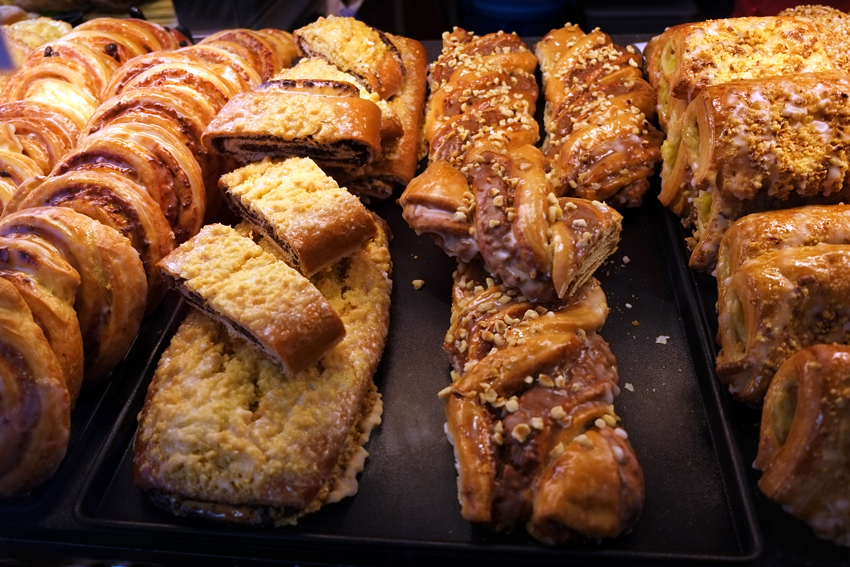 Did I mention Stuttgart pastry . . . it would be worth moving here just for the pastry . . . . almost.
Did I mention Stuttgart pastry . . . it would be worth moving here just for the pastry . . . . almost.
 The Christmas Market spread along the entire length of Stuttgart's main walking street.
The Christmas Market spread along the entire length of Stuttgart's main walking street.
 Their were lots of pretty booths set up selling just about everything Christmas-related.
Their were lots of pretty booths set up selling just about everything Christmas-related.
 There was a lot of festive seasonal food for sale too.
There was a lot of festive seasonal food for sale too.
 We stopped for delicious sausages and Glühwein (roughly translated, "glow-wine").
We stopped for delicious sausages and Glühwein (roughly translated, "glow-wine").
 It was a beautiful, not-too-cold night in Stuttgart. There were many tourists in the crowd that night (all, eventually, heading to Rothenburg the next day, we found out).
It was a beautiful, not-too-cold night in Stuttgart. There were many tourists in the crowd that night (all, eventually, heading to Rothenburg the next day, we found out).
 It was a wonderful evening to stroll around with the entire population of Stuttgart looking at the fun and interesting booths.
It was a wonderful evening to stroll around with the entire population of Stuttgart looking at the fun and interesting booths.
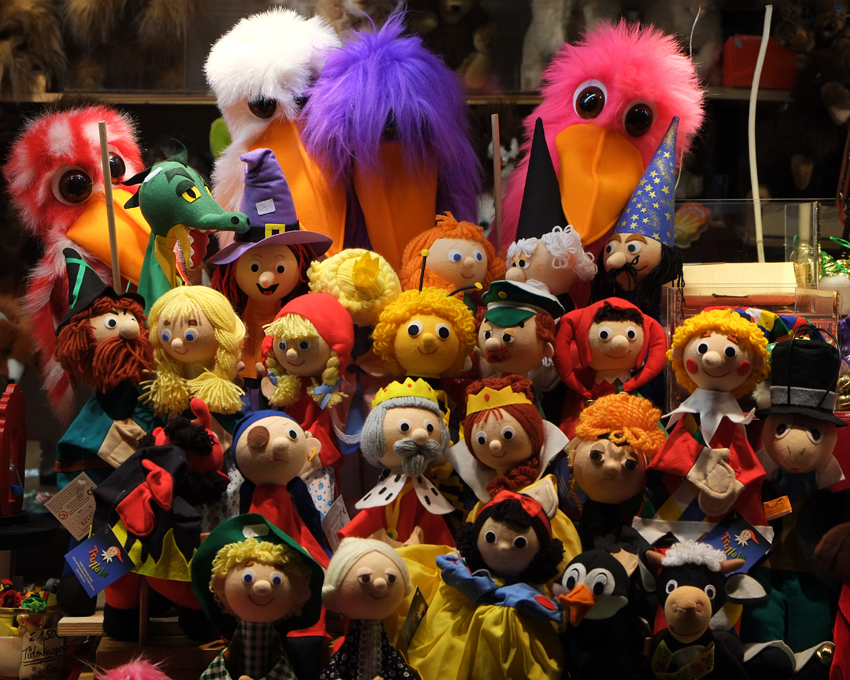 We were tempted . . . . but where would we put it?
We were tempted . . . . but where would we put it?
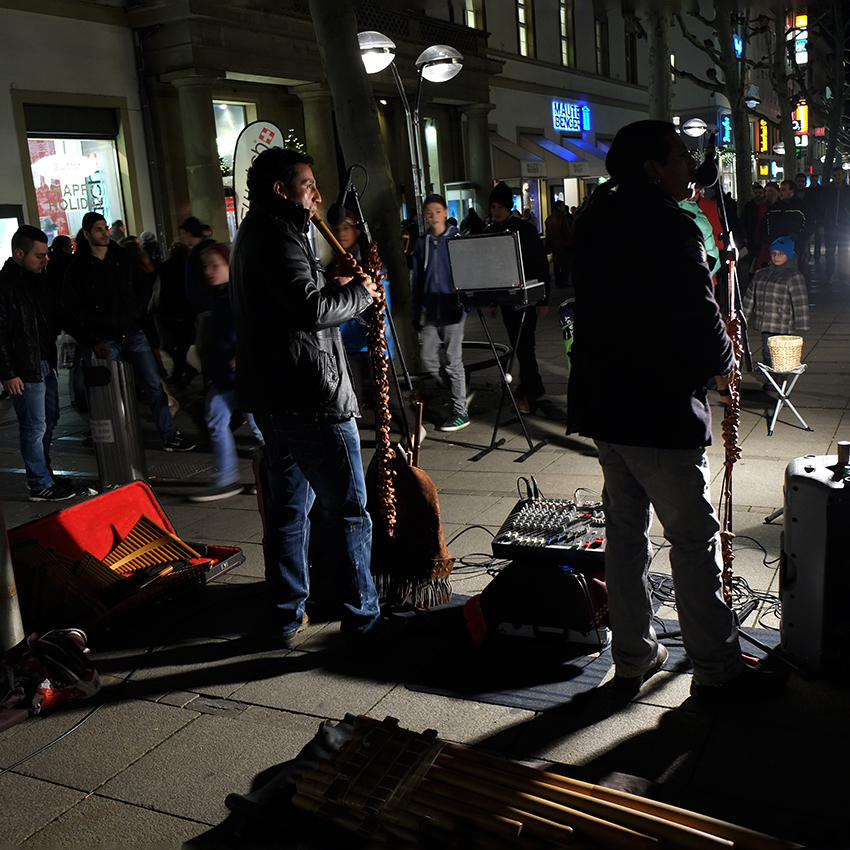 There have been Bolivian street musicians in EVERY European city I have visited in the last twenty years: Stuttgart was no exception! These guys were playing a kind of Bolivian Space Music. Very esoteric.
There have been Bolivian street musicians in EVERY European city I have visited in the last twenty years: Stuttgart was no exception! These guys were playing a kind of Bolivian Space Music. Very esoteric.
 A brightly lit merry-go-round tested the dynamic range capabilities of the new Fuji X-E1 camera. Excellent!
A brightly lit merry-go-round tested the dynamic range capabilities of the new Fuji X-E1 camera. Excellent!
 Did they only use this Christmas Tree Bulb Ferris Wheel one month of the year? Who knows . . . it was beautiful!
Did they only use this Christmas Tree Bulb Ferris Wheel one month of the year? Who knows . . . it was beautiful!
 I imagine that the shapes and sizes of these Christmas Gingerbread Hearts have huge significance to the residents of Stuttgart.
I imagine that the shapes and sizes of these Christmas Gingerbread Hearts have huge significance to the residents of Stuttgart.
 About half way down the walking street my wife made the observation that all the buildings seemed new. Yes, they were . . . because most of Stuttgart was bombed into smithereens in WWII. Only a few old buildings remained, like this cathedral tower.
About half way down the walking street my wife made the observation that all the buildings seemed new. Yes, they were . . . because most of Stuttgart was bombed into smithereens in WWII. Only a few old buildings remained, like this cathedral tower.
 But the Stuttgart city fathers made the most of their suddenly new city by planting and trimming very lovely trees down the promenade.
But the Stuttgart city fathers made the most of their suddenly new city by planting and trimming very lovely trees down the promenade.
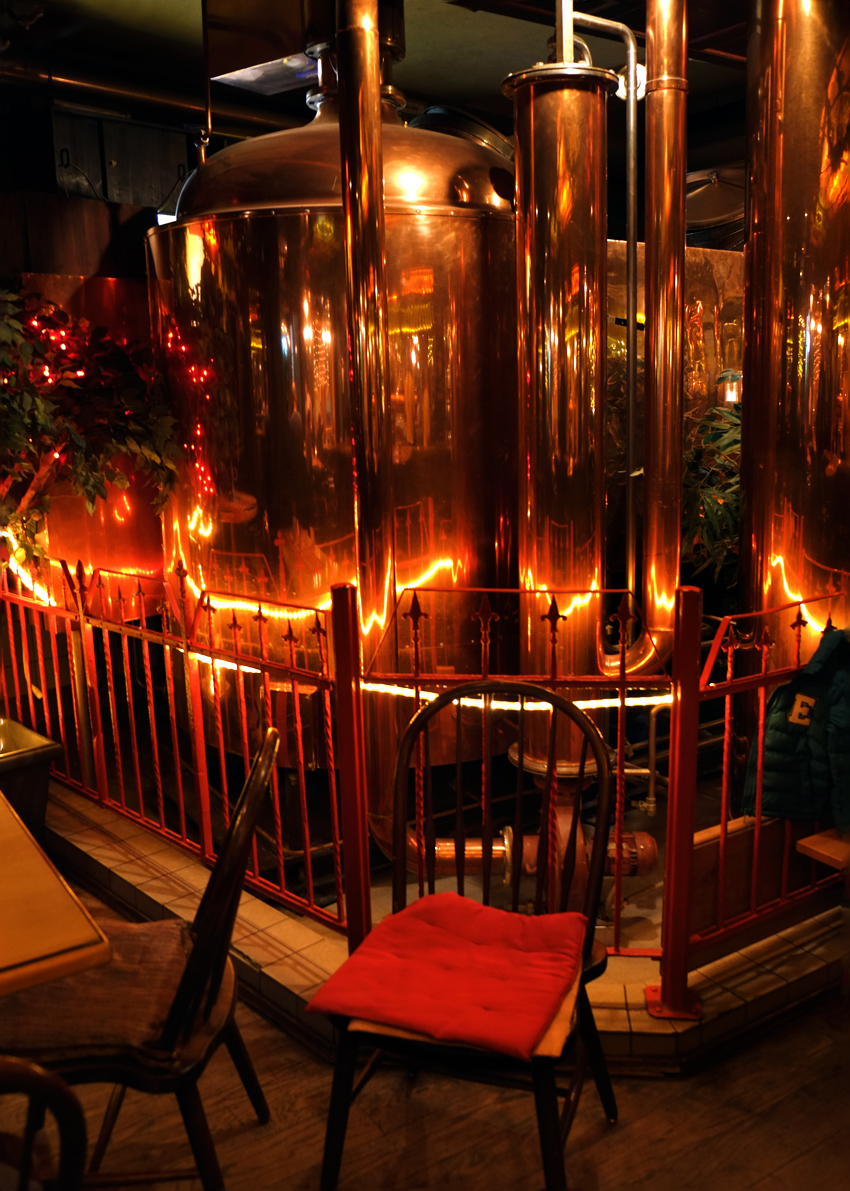 We found a nice beer garden that brewed their own ale, and had delicious pork schnitzel (me) and pork knuckle (my wife) with authentic sauerkraut.
We found a nice beer garden that brewed their own ale, and had delicious pork schnitzel (me) and pork knuckle (my wife) with authentic sauerkraut.
 We had a wonderful evening among the throngs before walking back to our hotel.
We had a wonderful evening among the throngs before walking back to our hotel.
 I saw this interesting poster in the gutter on our walk home. I'm guessing it is either a political poster for a politician running in the Big Partei, or it is an invitation to a Big Party. The arrangement of leaves is attractive.
I saw this interesting poster in the gutter on our walk home. I'm guessing it is either a political poster for a politician running in the Big Partei, or it is an invitation to a Big Party. The arrangement of leaves is attractive.
 Our hotel was clean and centrally located. We slept well after our long walk in the Christmas Market.
Our hotel was clean and centrally located. We slept well after our long walk in the Christmas Market.
 I took my obligatory art shot in the lobby of our hotel before we headed out the door. We had a train to catch.
I took my obligatory art shot in the lobby of our hotel before we headed out the door. We had a train to catch.
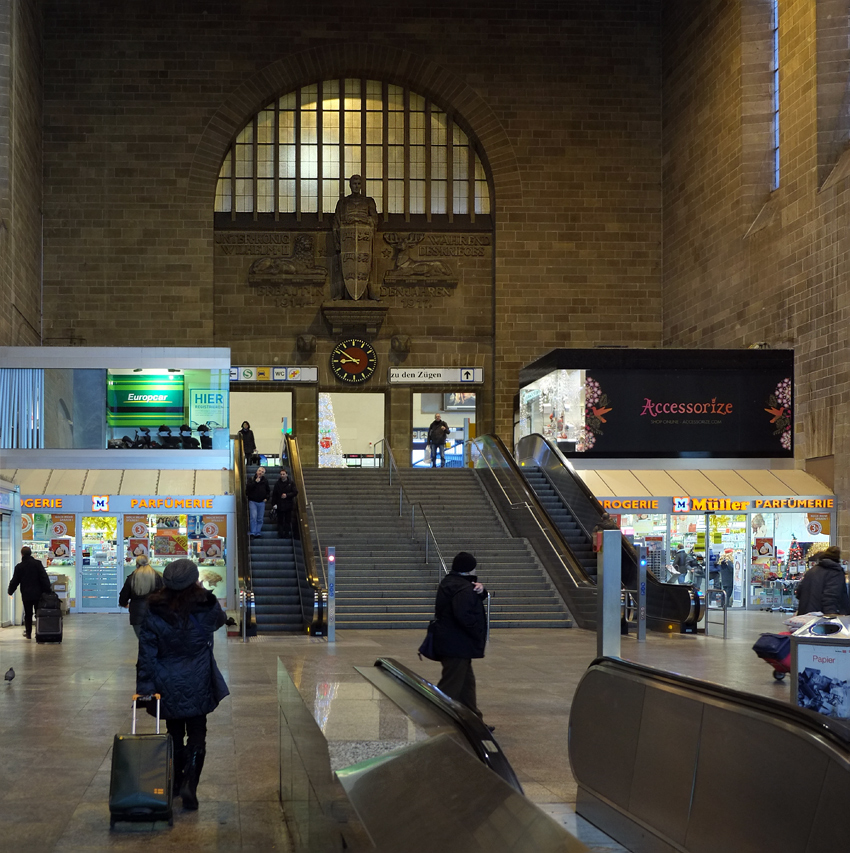 We hustled through the austere beauty of the Stuttgart Hauptbahnof to catch our train (after a quick stop for Starbucks). We would come back through this train station in a few days and then transit to the airport.
We hustled through the austere beauty of the Stuttgart Hauptbahnof to catch our train (after a quick stop for Starbucks). We would come back through this train station in a few days and then transit to the airport.
Day Trip: Huntly Town and Castle
 Wednesday, December 18, 2013 at 1:21AM
Wednesday, December 18, 2013 at 1:21AM  It was another cold and bleak Saturday . . . big clouds, a strong wind, and some blue sky poking through here and there. The days are short this time of year here northeastern Scotland. "Let's take a drive up to Huntly and see the castle this time." "OK." After a beautiful 40 mile drive from Abrdeen, we settled into a delicious lunch in the bar of the Gordon Arms Hotel, Huntly, Aberdeenshire, Scotland.
It was another cold and bleak Saturday . . . big clouds, a strong wind, and some blue sky poking through here and there. The days are short this time of year here northeastern Scotland. "Let's take a drive up to Huntly and see the castle this time." "OK." After a beautiful 40 mile drive from Abrdeen, we settled into a delicious lunch in the bar of the Gordon Arms Hotel, Huntly, Aberdeenshire, Scotland.
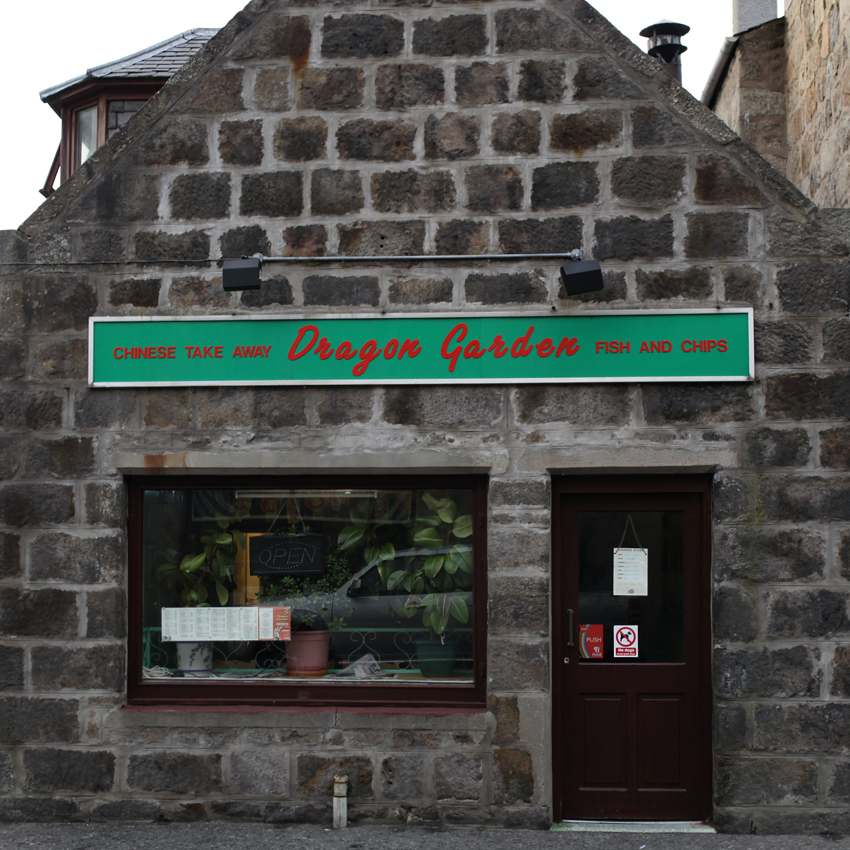 On our walk to Huntly Castle, my wife and I couldn't help but chuckle at this Chinese take-away. Literally every town in Scotland, no matter how big or small, has a Chinese take-away!
On our walk to Huntly Castle, my wife and I couldn't help but chuckle at this Chinese take-away. Literally every town in Scotland, no matter how big or small, has a Chinese take-away!
 We parked in the city center, and after a delightful lunch in the town square, and walked up the tree lined entry to Huntly Castle.
We parked in the city center, and after a delightful lunch in the town square, and walked up the tree lined entry to Huntly Castle.
 You come up on Huntly Castle from behind old walls . . . and get your first glimpses through the stone framed windows.
You come up on Huntly Castle from behind old walls . . . and get your first glimpses through the stone framed windows.
 The first castle was built on this spot in the 12th century, but it was torched in 1452. Sometime in the mid-1500s this beautiful structure was built in its place.
The first castle was built on this spot in the 12th century, but it was torched in 1452. Sometime in the mid-1500s this beautiful structure was built in its place.
 The beautiful and mysterious Huntly Castle ruins.
The beautiful and mysterious Huntly Castle ruins.
 The castle out-buildings held a few surprises: the killing floor of this sheep butchery must have been high technology at the time.
The castle out-buildings held a few surprises: the killing floor of this sheep butchery must have been high technology at the time.
 A sign by the Scottish Trust explained that these features were meant to contain sheep entrails and blood . . . haggis catchers!
A sign by the Scottish Trust explained that these features were meant to contain sheep entrails and blood . . . haggis catchers!
 The back, or working, side of Huntly Castle is very imposing on this grey late Autumn day.
The back, or working, side of Huntly Castle is very imposing on this grey late Autumn day.
 A structural element is missing off the back wall. The 'windows' are purely functional and meet features of the interior without care for the exterior aesthetic consequences . . . as defense is the prime consideration in castle building. My love of 'wall histories' was consummated in full here!
A structural element is missing off the back wall. The 'windows' are purely functional and meet features of the interior without care for the exterior aesthetic consequences . . . as defense is the prime consideration in castle building. My love of 'wall histories' was consummated in full here!
 A chilly afternoon at Huntly Castle.
A chilly afternoon at Huntly Castle.
 But it was time to explore the interior of this famous, so called, "haunted" castle.
But it was time to explore the interior of this famous, so called, "haunted" castle.
 The hunting scenes over the door attest to the castle's past use as a stop-over for royal visitors of the time on hunting trips to the wilderness of Scotland. Robert the Bruce even stayed in the older castle in 1307.
The hunting scenes over the door attest to the castle's past use as a stop-over for royal visitors of the time on hunting trips to the wilderness of Scotland. Robert the Bruce even stayed in the older castle in 1307.
 The interior was empty and parts of the roof were open to the sky.
The interior was empty and parts of the roof were open to the sky.
 The castle was completely abandoned by the 18th century . . . and all the interior decor and features have long since been stripped. The Scottish National Trust seems to have been responsible for installing the flooring on the second level and the improvised structural bracing seen here and there.
The castle was completely abandoned by the 18th century . . . and all the interior decor and features have long since been stripped. The Scottish National Trust seems to have been responsible for installing the flooring on the second level and the improvised structural bracing seen here and there.
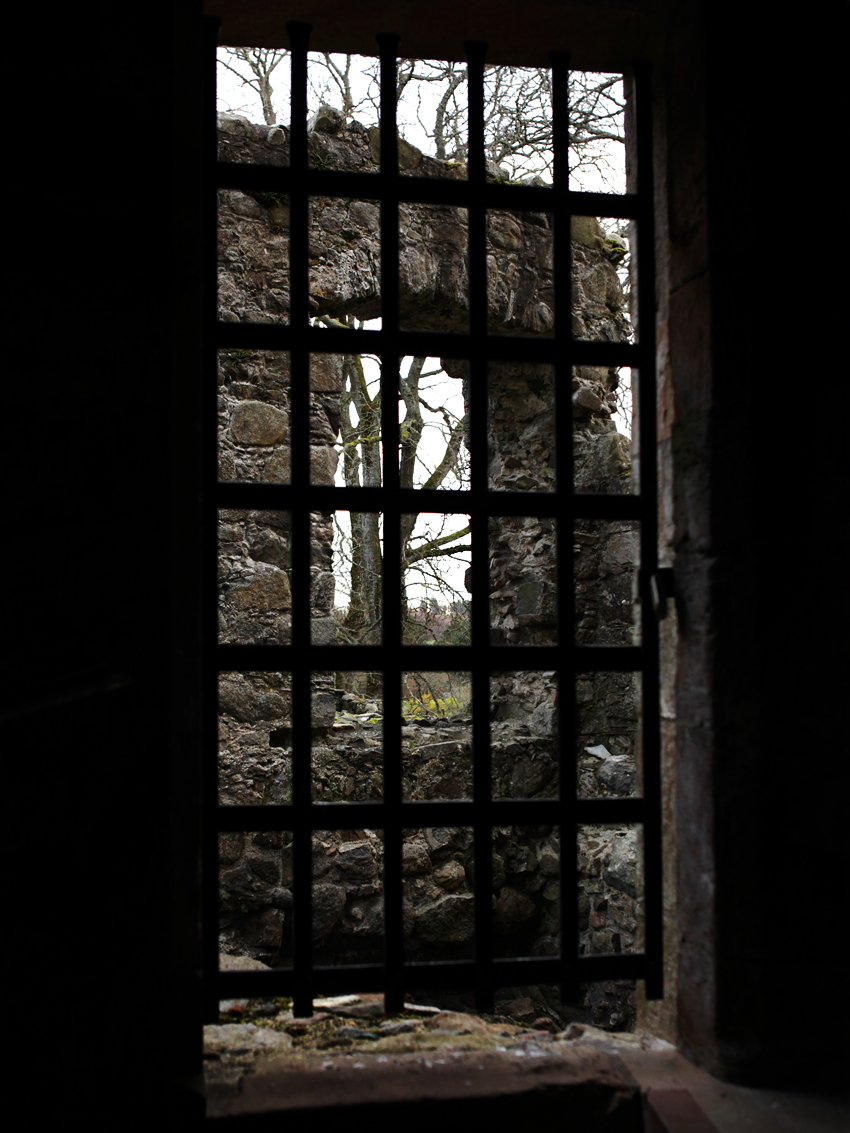 A window view out on the gloomy day. The sun never rises very far into the sky this time of year, but it goes down very slowly which extends the sunsets for a long time.
A window view out on the gloomy day. The sun never rises very far into the sky this time of year, but it goes down very slowly which extends the sunsets for a long time.
 As I made my way over to the rooms on the south side, the light became fantastic.
As I made my way over to the rooms on the south side, the light became fantastic.
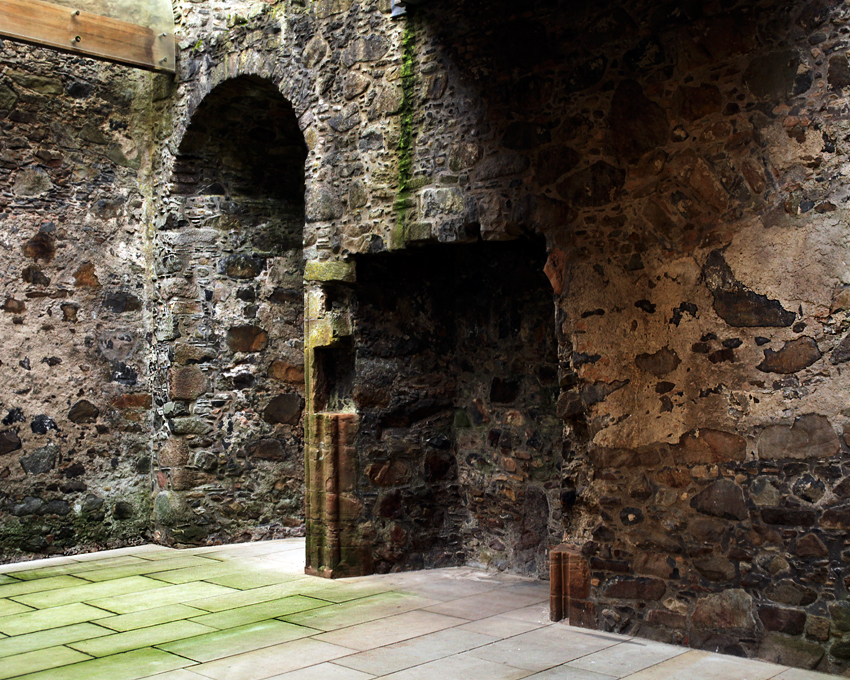 You can see the structural bracing in the yummie light and shadow . . . I'll try it in Black and White . . . .
You can see the structural bracing in the yummie light and shadow . . . I'll try it in Black and White . . . .
 Oh yes.
Oh yes.
 The sun at last sunk beneath the low cloud cover to shine a golden light through the windows of Huntly Castle!
The sun at last sunk beneath the low cloud cover to shine a golden light through the windows of Huntly Castle!
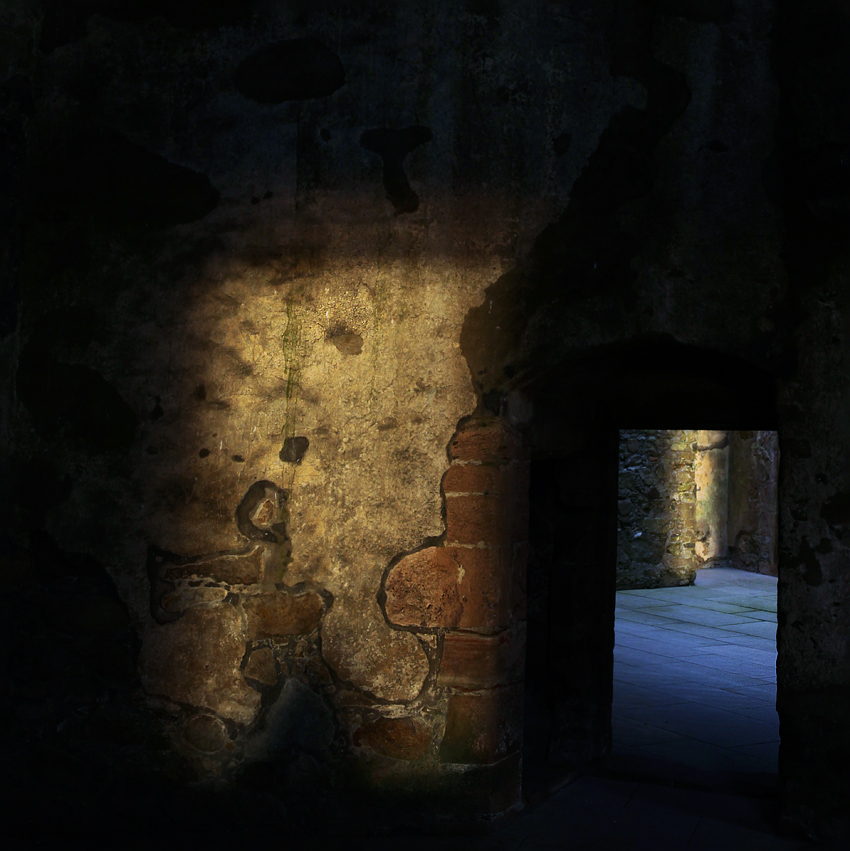 Oh! The light!
Oh! The light!
 I realized I was standing in the castle tower, and looking up I was surprised to see the high walls lit with golden light.
I realized I was standing in the castle tower, and looking up I was surprised to see the high walls lit with golden light.
 An otherworldly sight! The castle tower lit from the inside!
An otherworldly sight! The castle tower lit from the inside!
 The recreated slotted ceiling lattice and fine light.
The recreated slotted ceiling lattice and fine light.
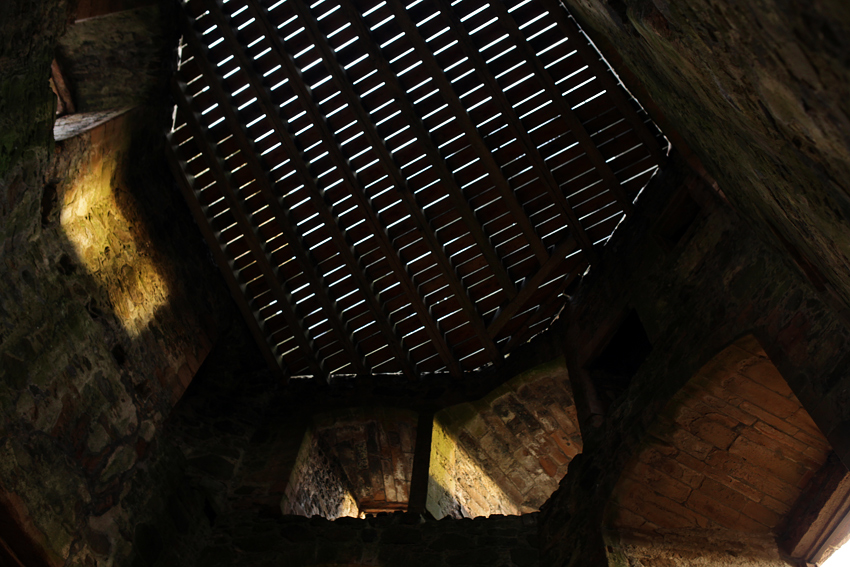 Perhaps one of the best photos I have ever taken . . . the only thing missing is a body in a noose hanging from the high castle tower ceiling. Too bad I didn't have my 16-35 L-II lens with me.
Perhaps one of the best photos I have ever taken . . . the only thing missing is a body in a noose hanging from the high castle tower ceiling. Too bad I didn't have my 16-35 L-II lens with me.
 A marvelous, cold, quiet space.
A marvelous, cold, quiet space.
 There are many stories of ghosts in Huntly Castle lore. This happens not to be one of them . . . it's my wife's dancing shadow.
There are many stories of ghosts in Huntly Castle lore. This happens not to be one of them . . . it's my wife's dancing shadow.
 Castle shadow ballerina.
Castle shadow ballerina.
 Self Portrait With Wall no.24. I'm a shadow of my former self.
Self Portrait With Wall no.24. I'm a shadow of my former self.
 All good things must come to an end . . . time to leave Huntly Castle. It gets dark early, and we have a 40 mile drive ahead of us.
All good things must come to an end . . . time to leave Huntly Castle. It gets dark early, and we have a 40 mile drive ahead of us.
 I was met with this skyview as soon as I stepped out of the castle door.
I was met with this skyview as soon as I stepped out of the castle door.
 The Aberdeenshire countryside around the castle was delightful.
The Aberdeenshire countryside around the castle was delightful.
 The preferred view was straight up into the Autumn Scottish sky.
The preferred view was straight up into the Autumn Scottish sky.
 The sun is always low in the sky in this part of Scotland at this time of year. Wonderful moods on the day.
The sun is always low in the sky in this part of Scotland at this time of year. Wonderful moods on the day.
 We passed around the front of Huntly Castle on our way out.
We passed around the front of Huntly Castle on our way out.
 What an imposing structure it must have been in its day.
What an imposing structure it must have been in its day.
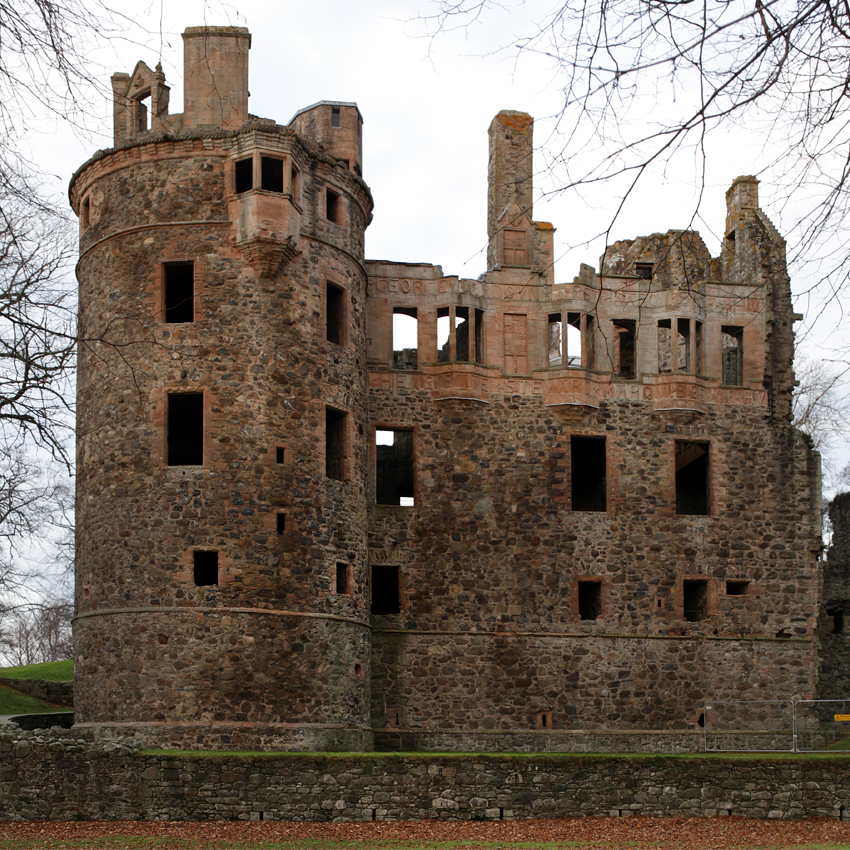 Huntly Castle ruins in their full splendor. The golden light of only moments earlier had gone. I looked up at the tower and was glad I was lucky enough to be there at the right moment today.
Huntly Castle ruins in their full splendor. The golden light of only moments earlier had gone. I looked up at the tower and was glad I was lucky enough to be there at the right moment today.
 The walk back to Huntly through this line of old trees was very pleasant.
The walk back to Huntly through this line of old trees was very pleasant.
 The trees, in anticipation of an icy winter, had pumped up their turgor (sap pressure) to guard against freezing. I'm glad I took that botany course in university now.
The trees, in anticipation of an icy winter, had pumped up their turgor (sap pressure) to guard against freezing. I'm glad I took that botany course in university now.
 We returned to Huntly under an ever-changing light.
We returned to Huntly under an ever-changing light.
 We walked through sunset-bathed Huntly, poking our noses into small shops. We stopped in one cafe for free coffee and pastries . . . it was their grand opening!
We walked through sunset-bathed Huntly, poking our noses into small shops. We stopped in one cafe for free coffee and pastries . . . it was their grand opening!
 We enjoyed our day trip to Huntly, but it was time to head home. We wanted to stop at one of the Farm Stores we passed on the way . . . and I had hopes of standing in a farmer's field and shooting the rapidly developing sunset.
We enjoyed our day trip to Huntly, but it was time to head home. We wanted to stop at one of the Farm Stores we passed on the way . . . and I had hopes of standing in a farmer's field and shooting the rapidly developing sunset.
 Th sunset did not disappoint! I let my darling wife off at the Farm Store and drove out into the countryside on a farmer's road.
Th sunset did not disappoint! I let my darling wife off at the Farm Store and drove out into the countryside on a farmer's road.
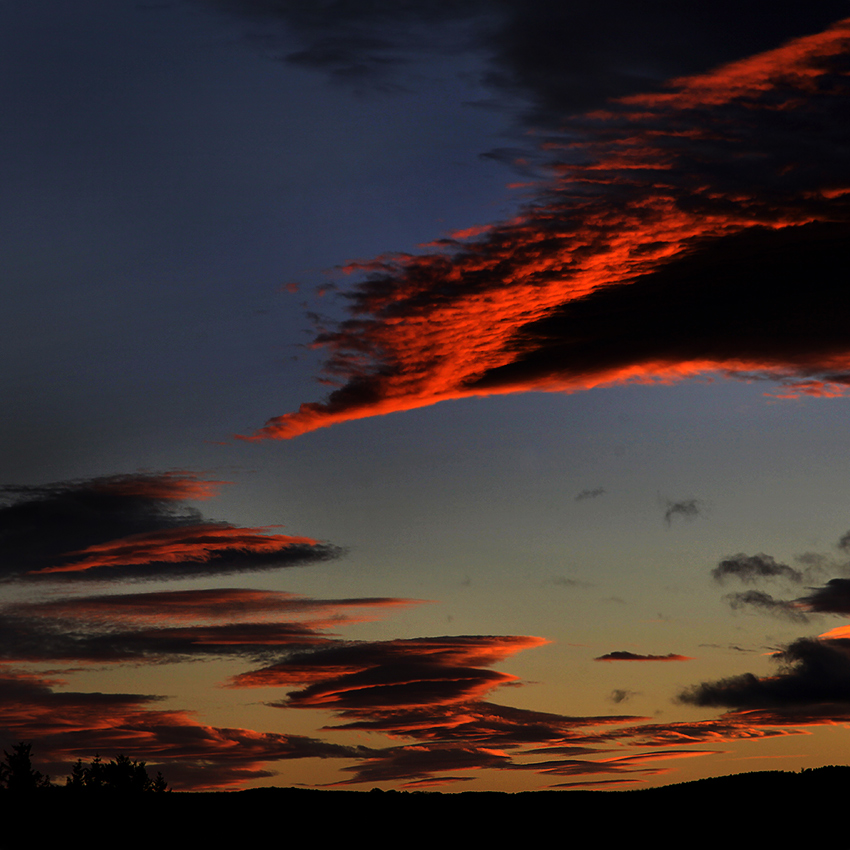 With the sun setting at such an acute angle, it took many minutes to fully develop.
With the sun setting at such an acute angle, it took many minutes to fully develop.
 In the tropics, like Bangkok (where I lived until five months ago), a sunset would begin and end in a matter of minutes . . . .
In the tropics, like Bangkok (where I lived until five months ago), a sunset would begin and end in a matter of minutes . . . .
 . . . but this most beautiful of sunsets lasted nearly 40 minutes.
. . . but this most beautiful of sunsets lasted nearly 40 minutes.
 This horizontal swirling braid moved fast enough for me to see it twisting. Incredible.
This horizontal swirling braid moved fast enough for me to see it twisting. Incredible.
 If there were such things as flying saucers, this is the cloud from which they should descend! WOW!
If there were such things as flying saucers, this is the cloud from which they should descend! WOW!
 It was a big sky full of beauty.
It was a big sky full of beauty.
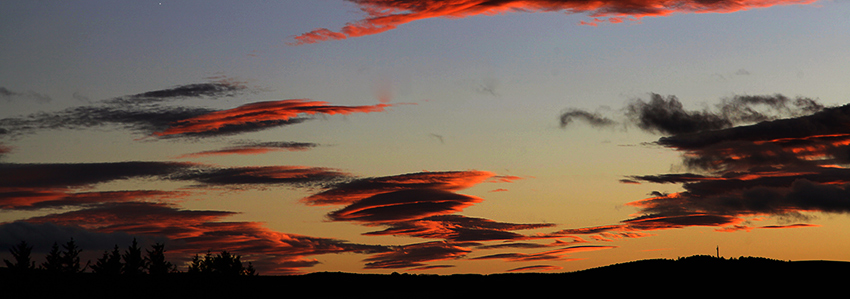 I chose the Canon 24-105mm L-series lens, and tried to keep it around f8 hand-held for clarity.
I chose the Canon 24-105mm L-series lens, and tried to keep it around f8 hand-held for clarity.
 As I stood by my car getting ready to put the camera away, I happened to look straight up . . . .
As I stood by my car getting ready to put the camera away, I happened to look straight up . . . .
 . . . and caught this shot of the reflected, and refracting, light of the sunset on ice crystals from yet another weather pattern moving in from the west. What a great way to end the day.
. . . and caught this shot of the reflected, and refracting, light of the sunset on ice crystals from yet another weather pattern moving in from the west. What a great way to end the day.
A Week-End Away: St. Andrews and Sterling Castle
 Saturday, November 23, 2013 at 5:37PM
Saturday, November 23, 2013 at 5:37PM St. ANDREWS:
 We vowed to spend at least one night a month away from our house, and November was quickly passing. We decided on a short week-end to the ancient university town of St. Andrews, just an hour-and-a-half away. We stopped at one of the great features of the Scottish highways, the Farm Store, for some stocking up of breads, cheeses, and chutneys.
We vowed to spend at least one night a month away from our house, and November was quickly passing. We decided on a short week-end to the ancient university town of St. Andrews, just an hour-and-a-half away. We stopped at one of the great features of the Scottish highways, the Farm Store, for some stocking up of breads, cheeses, and chutneys.
 St. Andrews is another amazing old Scottish town. In addition, it is the home of St. Andrews University (celebrating its 600th yea, as well as having the title of "the home of golf" with the Royal and Ancient Golf Club just at the edge of town. For a small town it has a lot to see and do . . . including some pretty good shopping.
St. Andrews is another amazing old Scottish town. In addition, it is the home of St. Andrews University (celebrating its 600th yea, as well as having the title of "the home of golf" with the Royal and Ancient Golf Club just at the edge of town. For a small town it has a lot to see and do . . . including some pretty good shopping.
 St. Andrews is a wonderful walking around town. Great winter light and deep shadows.
St. Andrews is a wonderful walking around town. Great winter light and deep shadows.
 The main thoroughfare runs down to the university and has some fine churches.
The main thoroughfare runs down to the university and has some fine churches.
 This is the tower of Holy Trinity at St. Andrews University.
This is the tower of Holy Trinity at St. Andrews University.
 There is a great collection of fanciful architecture befitting a great university town.
There is a great collection of fanciful architecture befitting a great university town.
 This old dwelling is cracked from top to bottom, but there are iron stays holding it together. Ah, student housing!
This old dwelling is cracked from top to bottom, but there are iron stays holding it together. Ah, student housing!
 I wandered the dark, shady, photogenic medieval lanes in search of the textures Time had left behind.
I wandered the dark, shady, photogenic medieval lanes in search of the textures Time had left behind.
 Beautiful scenes were not hard to find.
Beautiful scenes were not hard to find.
 The days are very short here in northern Scotland, so the light is always low and weak on the stone houses.
The days are very short here in northern Scotland, so the light is always low and weak on the stone houses.
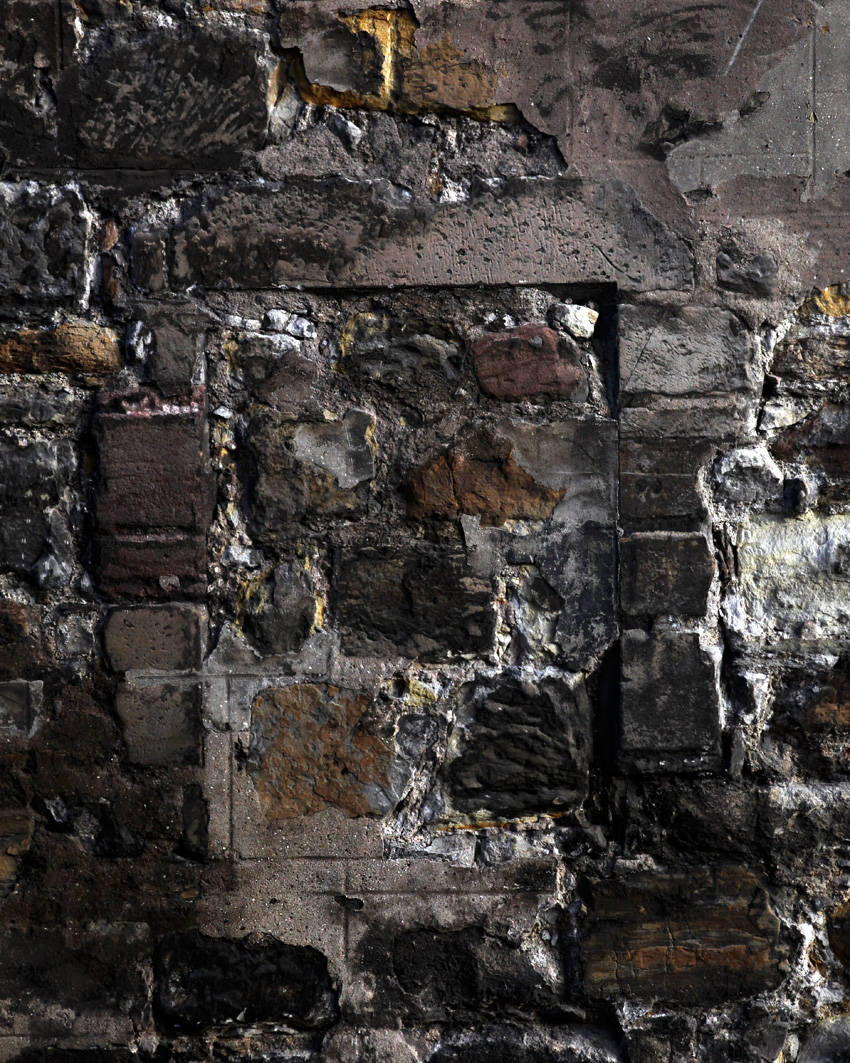 I love capturing "Wall History Portraits."
I love capturing "Wall History Portraits."
 A new twist on the old concept of watch dog.
A new twist on the old concept of watch dog.
 St. Andrews was not built yesterday. It was built by The Freemasons a long time ago. 1561 was the date on this still occupied house.
St. Andrews was not built yesterday. It was built by The Freemasons a long time ago. 1561 was the date on this still occupied house.
 We currently enjoy living in a stone house from the 1880s In Aberdeen, but my dream is to live in a 500 year old stone house some day.
We currently enjoy living in a stone house from the 1880s In Aberdeen, but my dream is to live in a 500 year old stone house some day.
 A persistent theme among my photographic interests is Old Doors. I find them powerful images of transition - from outside to inside - from inside to outside. The threshold.
A persistent theme among my photographic interests is Old Doors. I find them powerful images of transition - from outside to inside - from inside to outside. The threshold.
 I zig-zagged back and forth across St. Andrews' small streets and suddenly found myself at the sea side.
I zig-zagged back and forth across St. Andrews' small streets and suddenly found myself at the sea side.
 St. Andrews Castle ruins. There has been a castle on this site since 1189 and has played prominent roles in Scottish history many times . . . and was destroyed many times
St. Andrews Castle ruins. There has been a castle on this site since 1189 and has played prominent roles in Scottish history many times . . . and was destroyed many times
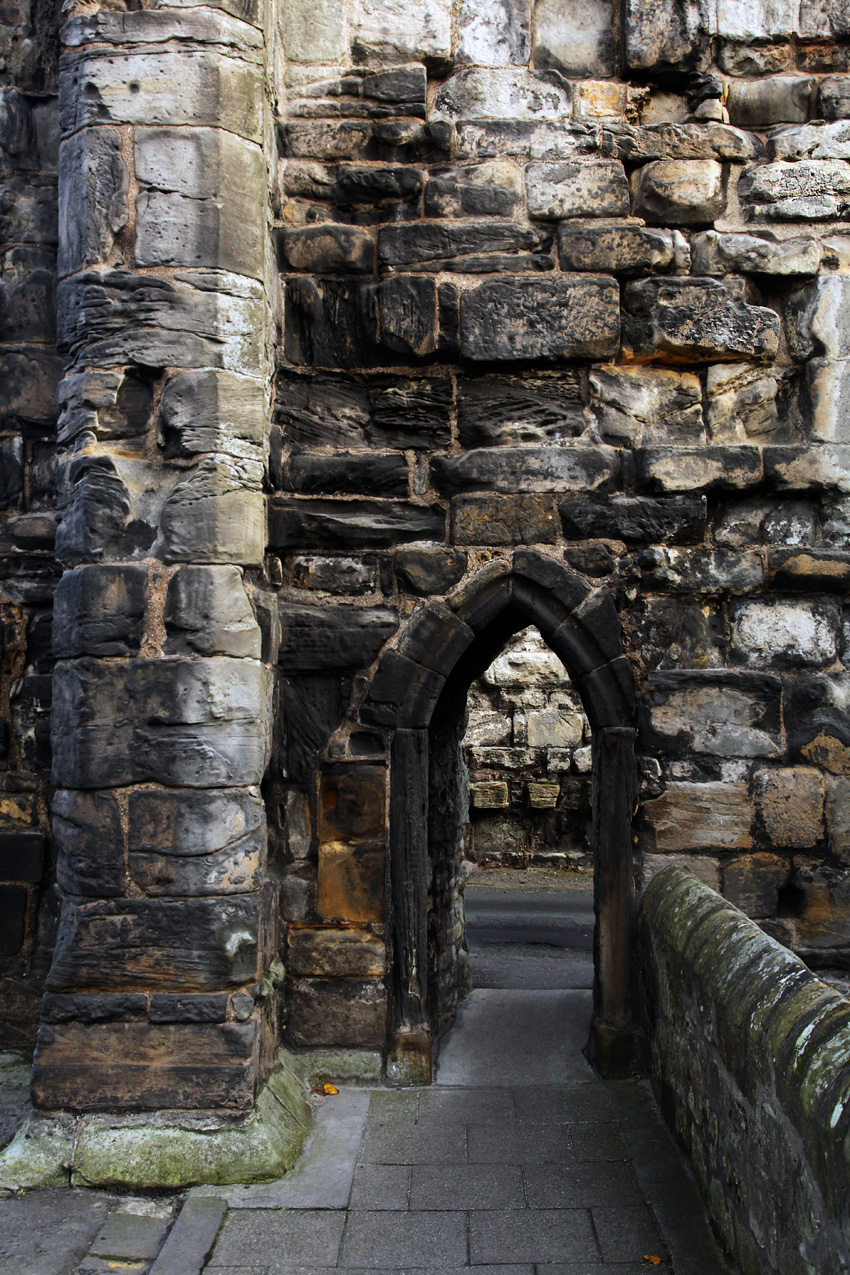 My wanderings eventually lead me to the ancient ruins I had been seeking.
My wanderings eventually lead me to the ancient ruins I had been seeking.
 There is no shortage of ancient ruins in St. Andrews. In fact, there are so many ruins that at some point the city fathers decided that the quickest route from A to B was right through an ancient chapel! I have not seen this kind of thing since Luxor in Egypt.
There is no shortage of ancient ruins in St. Andrews. In fact, there are so many ruins that at some point the city fathers decided that the quickest route from A to B was right through an ancient chapel! I have not seen this kind of thing since Luxor in Egypt.
 Rounding the next corner I was surprised by something out of a Hieronymus Bosch painnting! A surrealistic architectural structure: The complex of ruins of St. Andrews Cathedral (circa 1158).
Rounding the next corner I was surprised by something out of a Hieronymus Bosch painnting! A surrealistic architectural structure: The complex of ruins of St. Andrews Cathedral (circa 1158).
 Imagine what this must have looked like before it was abandoned in 1561 and left to collapse at the end of the 16th century.
Imagine what this must have looked like before it was abandoned in 1561 and left to collapse at the end of the 16th century.
 The St. Andrews Cathedral ruins site in the fading light.
The St. Andrews Cathedral ruins site in the fading light.



 Restoration and preservation of the site did not commence until 1826, even though most of the stones and features had long since been carted away.
Restoration and preservation of the site did not commence until 1826, even though most of the stones and features had long since been carted away.






 The original magnificence of St. Andrews Cathedral can only be guessed at.
The original magnificence of St. Andrews Cathedral can only be guessed at.
 The wall that surrounds the St. Andrews Cathedral is lined with crypts and inscriptions.
The wall that surrounds the St. Andrews Cathedral is lined with crypts and inscriptions.
 There were many great men interred here. . . . including the logician and literary historian, William Spalding (born in Aberdeen in 1809). I vowed to remember him and read one of his books.
There were many great men interred here. . . . including the logician and literary historian, William Spalding (born in Aberdeen in 1809). I vowed to remember him and read one of his books.
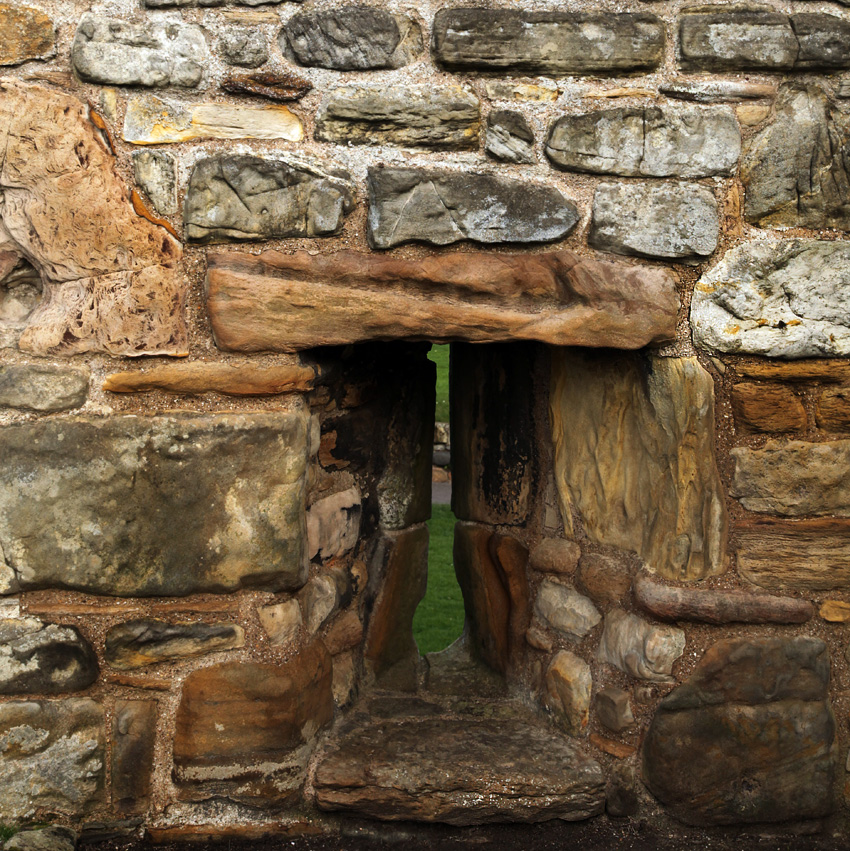 Centuries of inclement weather have worn these gun slots in peculiar ways.
Centuries of inclement weather have worn these gun slots in peculiar ways.
 One way to be remembered. This likeness was on a crypt . . . but there was no name.
One way to be remembered. This likeness was on a crypt . . . but there was no name.
 I don't know why wandering around an 900 year old grave yard is so interesting.
I don't know why wandering around an 900 year old grave yard is so interesting.
 A cold and fine afternoon with steep, sharp light on the many surprising views.
A cold and fine afternoon with steep, sharp light on the many surprising views.
 The old cathedral church yard with view to the old town. So quaint . . . so Scotland.
The old cathedral church yard with view to the old town. So quaint . . . so Scotland.
 St. Andrews Cathedral must have been a wondrous place before it fell.
St. Andrews Cathedral must have been a wondrous place before it fell.
 On these giant footings sat massive columns that held the vaulted roof aloft.
On these giant footings sat massive columns that held the vaulted roof aloft.
 I enjoyed playing around with all the possibilities of framing my photos.
I enjoyed playing around with all the possibilities of framing my photos.
 An endless contrast between the fading sun and the grey winter shadows enveloped the entire grave yard.
An endless contrast between the fading sun and the grey winter shadows enveloped the entire grave yard.
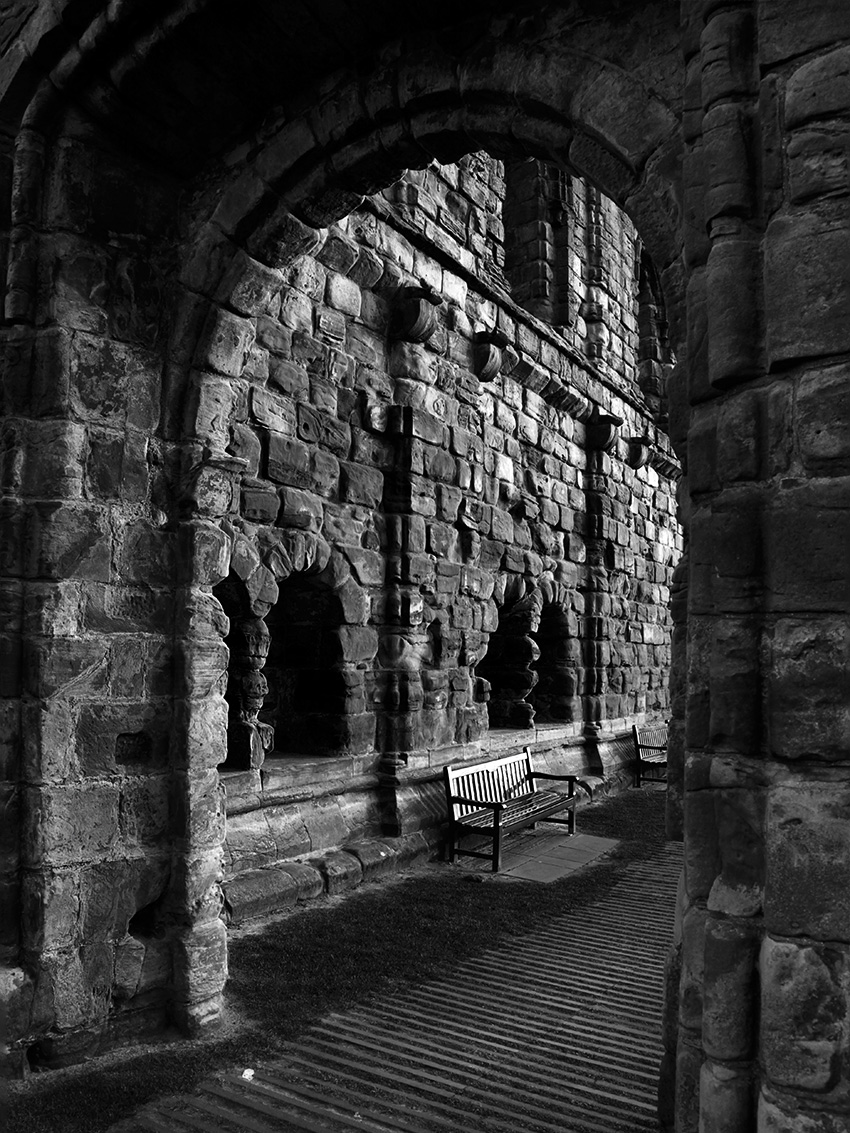 After post-processing many images I finally realized that this light was ideal for black and white photography.
After post-processing many images I finally realized that this light was ideal for black and white photography.
 I spent over an hour inside the St. Andrews Cathedral 'church yard' . . . it was time to leave. I joined the other 10+ tourist photographers for my chance to take this must-have shot. But which shot to take . . .
I spent over an hour inside the St. Andrews Cathedral 'church yard' . . . it was time to leave. I joined the other 10+ tourist photographers for my chance to take this must-have shot. But which shot to take . . .
 . . . perhaps THIS is the ultimate St. Andrews Cathedral ruins photo . . . or maybe . . . .
. . . perhaps THIS is the ultimate St. Andrews Cathedral ruins photo . . . or maybe . . . .
 . . . no, this is the ultimate view . . .
. . . no, this is the ultimate view . . .
 I know I will be back. Time to walk around town before the light fades altogether.
I know I will be back. Time to walk around town before the light fades altogether.
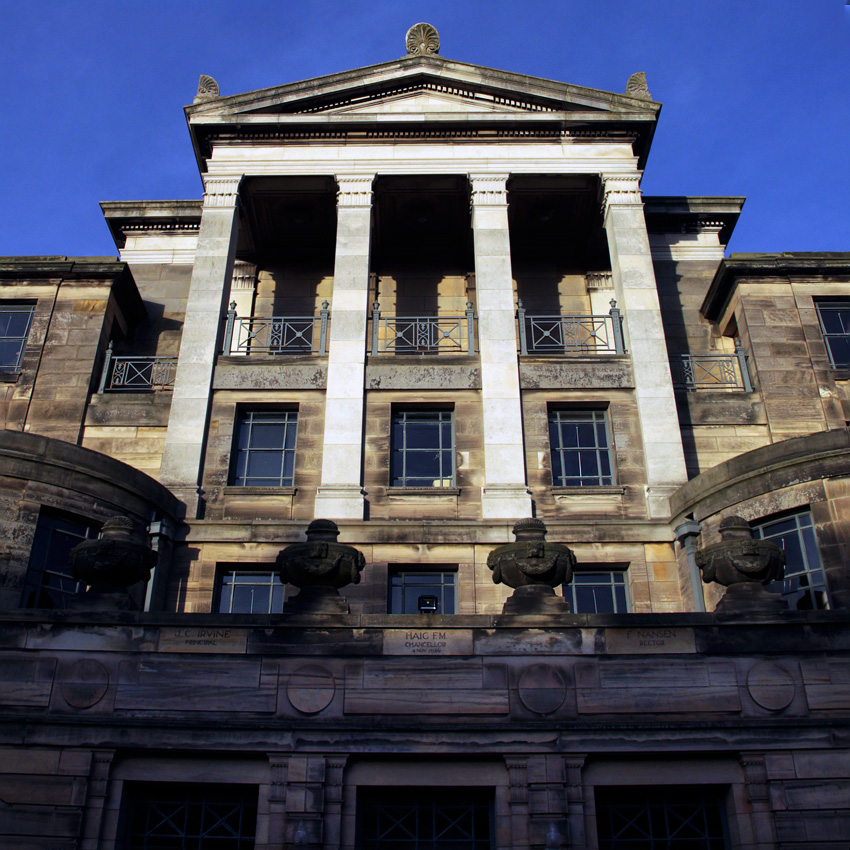 I wanted to find the University of St. Andrews, celebrating it's 600th birthday!
I wanted to find the University of St. Andrews, celebrating it's 600th birthday!
 I love university campuses anyway . . . they are an island outside of the contemporary, meant to make meaning. St. Andrews University did not disappoint.
I love university campuses anyway . . . they are an island outside of the contemporary, meant to make meaning. St. Andrews University did not disappoint.
 Stunning architecture and Autumn light and color.
Stunning architecture and Autumn light and color.
 Autumn light!
Autumn light!
 I returned to our B&B via the sea view route. The sea is always present in St. Andrews . . . as is The Castle.
I returned to our B&B via the sea view route. The sea is always present in St. Andrews . . . as is The Castle.

 Wonderful old university structures along the coast.
Wonderful old university structures along the coast.
 Let us not forget that St. Andrews is equally famous for it's title of "home of golf" with the world's oldest golf course just at the edge of town.
Let us not forget that St. Andrews is equally famous for it's title of "home of golf" with the world's oldest golf course just at the edge of town.
 I was surprised to see such a wonderful stretch of beach adjacent to the golf course.
I was surprised to see such a wonderful stretch of beach adjacent to the golf course.
 People everywhere love walking on the beach at sunset.
People everywhere love walking on the beach at sunset.
 I rendezvoused with my wife at a pub around the corner from St. Andrew's Golf Course. It was filled with memorabilia from the many "Open Championships" held here. But the crowd was not interested in golf . . . this was a rugby day and the New Zealand All Blacks were playing England on the television. Everyone was rooting for the Kiwis and against England! I left my camera at the B&B and we went on to a wonderful evening out at a fabulous restaurant.
I rendezvoused with my wife at a pub around the corner from St. Andrew's Golf Course. It was filled with memorabilia from the many "Open Championships" held here. But the crowd was not interested in golf . . . this was a rugby day and the New Zealand All Blacks were playing England on the television. Everyone was rooting for the Kiwis and against England! I left my camera at the B&B and we went on to a wonderful evening out at a fabulous restaurant.
 The next morning I woke before first light to see the town at sunrise.
The next morning I woke before first light to see the town at sunrise.
 I walked along the seaside path as the sun rose over the North Sea.
I walked along the seaside path as the sun rose over the North Sea.
 I was greeted with an exquisite sunrise from the end of the old St. Andrews jetty.
I was greeted with an exquisite sunrise from the end of the old St. Andrews jetty.
 As the morning light expanded, the marshes leading to the boat basin came into view as the tide rose.
As the morning light expanded, the marshes leading to the boat basin came into view as the tide rose.
 I was the only person outside to see this new dawn.
I was the only person outside to see this new dawn.
 Many fishermen stood around waiting for the tide to rise enough to free their boats for the day's labor.
Many fishermen stood around waiting for the tide to rise enough to free their boats for the day's labor.
 Some of the fishermen began to load their crab pots into their teetering boats.
Some of the fishermen began to load their crab pots into their teetering boats.
 It was very pretty here . . . I could have stayed all day . . . but we had plans for the day.
It was very pretty here . . . I could have stayed all day . . . but we had plans for the day.
 I walked back to our B&B fast, only taking a few photos . . . like this ivy covered cottage . . . completely archetypical. I was hungry.
I walked back to our B&B fast, only taking a few photos . . . like this ivy covered cottage . . . completely archetypical. I was hungry.
 OK . . . I couldn't resist a few more photo of thi wonderful and ancient village . . .
OK . . . I couldn't resist a few more photo of thi wonderful and ancient village . . .
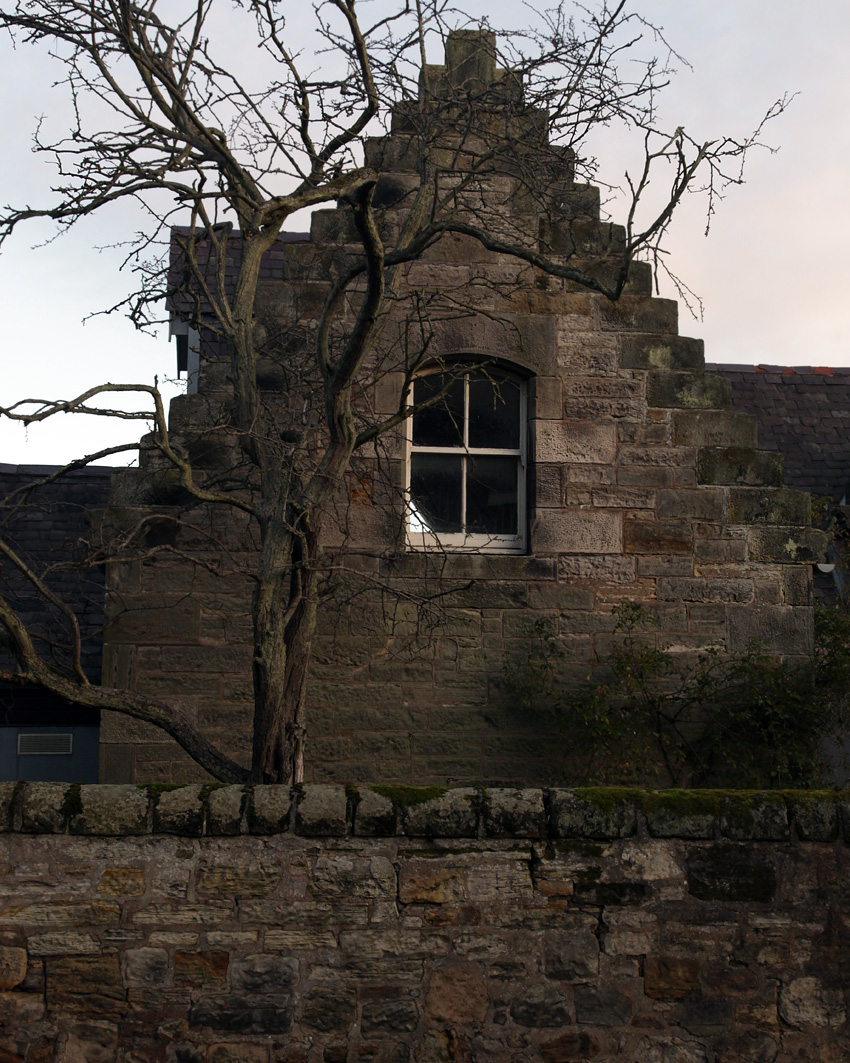 Just before `i rounded the corner to our B&B I took this photo . . . it says everythig about St. Andrews: stately, substanntial, and beautiful.
Just before `i rounded the corner to our B&B I took this photo . . . it says everythig about St. Andrews: stately, substanntial, and beautiful.
 At last the Nathan Guest House. I went in and joined my wife for a fabuluus breakfast, then packed up for the drive to Sterling. I promised my wife we wold drive straight there withut stopping, so no photos of the country roads . . .
At last the Nathan Guest House. I went in and joined my wife for a fabuluus breakfast, then packed up for the drive to Sterling. I promised my wife we wold drive straight there withut stopping, so no photos of the country roads . . .
STERLING CASTLE:
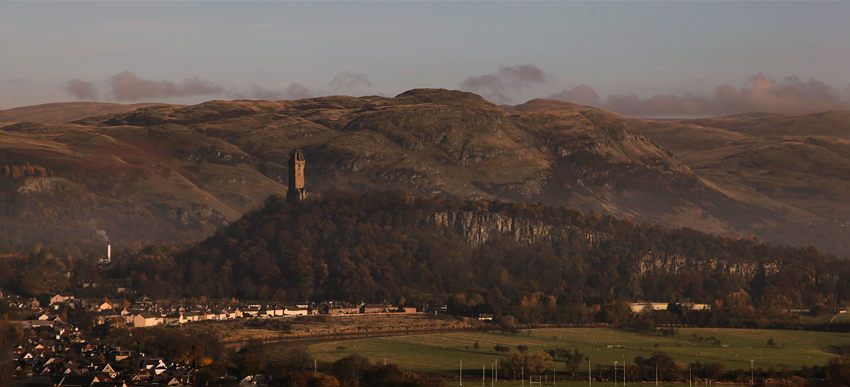 Sterling Castle sits atop a hill with commanding views of the surrounding valley. [The tower on a far hill is the Wallace Monument.]
Sterling Castle sits atop a hill with commanding views of the surrounding valley. [The tower on a far hill is the Wallace Monument.]
 At first we did not realize we were in the presence of such a great and historic castle. I was infatuated with the details . . .
At first we did not realize we were in the presence of such a great and historic castle. I was infatuated with the details . . .
 As the mist swirled around us, Sterling Castle came into view. Incredible. The archetypical castle.
As the mist swirled around us, Sterling Castle came into view. Incredible. The archetypical castle.
 Sterling Castle. The swirling mist changed the lighting on the castle surfaces every second.
Sterling Castle. The swirling mist changed the lighting on the castle surfaces every second.
 We walked around on the castle's outer defences . . . taking in the grandeur.
We walked around on the castle's outer defences . . . taking in the grandeur.
 The weak, low winter light on the surfaces lent an air of mystery.
The weak, low winter light on the surfaces lent an air of mystery.
 THE Perfect Castle!
THE Perfect Castle!
 Castle and morning mist-shrouded tree.
Castle and morning mist-shrouded tree.
 We entered the castle through several arched openings.
We entered the castle through several arched openings.
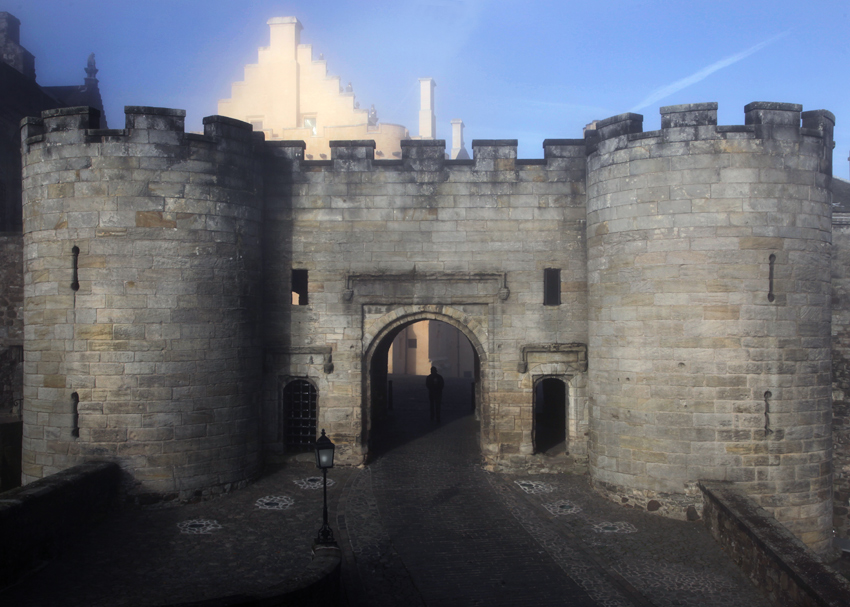 Sterling Castle gate.
Sterling Castle gate.
 What would we find inside?
What would we find inside?
 Sterling Castle is not a castle that was abandoned and then restored. It is a living castle with all of its original features still intact . . . a very rare find.
Sterling Castle is not a castle that was abandoned and then restored. It is a living castle with all of its original features still intact . . . a very rare find.
 Looking back out of the gates. The optical illusion here is interesting . . . Just how large are these stairs on the right?
Looking back out of the gates. The optical illusion here is interesting . . . Just how large are these stairs on the right?
 The oversized stairs led who-knows-where. I am so attracted to these castle doors and stairs: where do they lead? What mysteries are to be found beyond?
The oversized stairs led who-knows-where. I am so attracted to these castle doors and stairs: where do they lead? What mysteries are to be found beyond?
 The morning ground fog came and went. The interior courtyards were breathtaking. This is not a movie set, or a Disney creation, this is a real castle.
The morning ground fog came and went. The interior courtyards were breathtaking. This is not a movie set, or a Disney creation, this is a real castle.
 We walked though one of those doors and came out on the outer defensive ramparts of Sterling Castle. The castle-on-a-hill rose above the fog in the valley below. Wonderful.
We walked though one of those doors and came out on the outer defensive ramparts of Sterling Castle. The castle-on-a-hill rose above the fog in the valley below. Wonderful.
Medieval view from the castle.
 This would have been better as a movie clip: the fog strands and wisps were moving quickly below the castle.
This would have been better as a movie clip: the fog strands and wisps were moving quickly below the castle.
 We were transfixed by the ever-changing fog below the castle.
We were transfixed by the ever-changing fog below the castle.
 The fog sifted through the autumnal trees on the slopes of the castle mound.
The fog sifted through the autumnal trees on the slopes of the castle mound.
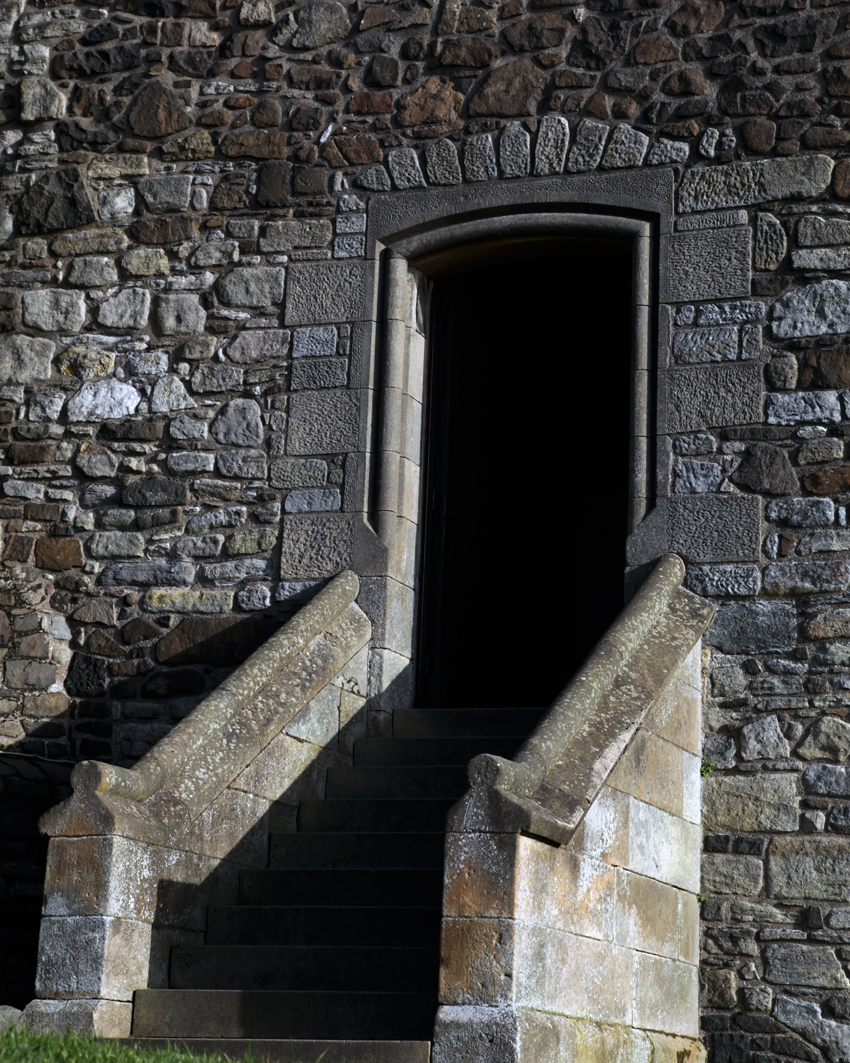 After a half hour of drop jawed revelry at the view, we entered Sterling Castle proper through this inconspicuous side door.
After a half hour of drop jawed revelry at the view, we entered Sterling Castle proper through this inconspicuous side door.
 Our back door entrance led to a Great Room. The Scottish Historical Trust provided historians in period costumes . . . and period consciousness, like this guy who stayed in 16th century character no matter what I asked.
Our back door entrance led to a Great Room. The Scottish Historical Trust provided historians in period costumes . . . and period consciousness, like this guy who stayed in 16th century character no matter what I asked.
 I have never really been this close to an authentic set of knight's armor.
I have never really been this close to an authentic set of knight's armor.
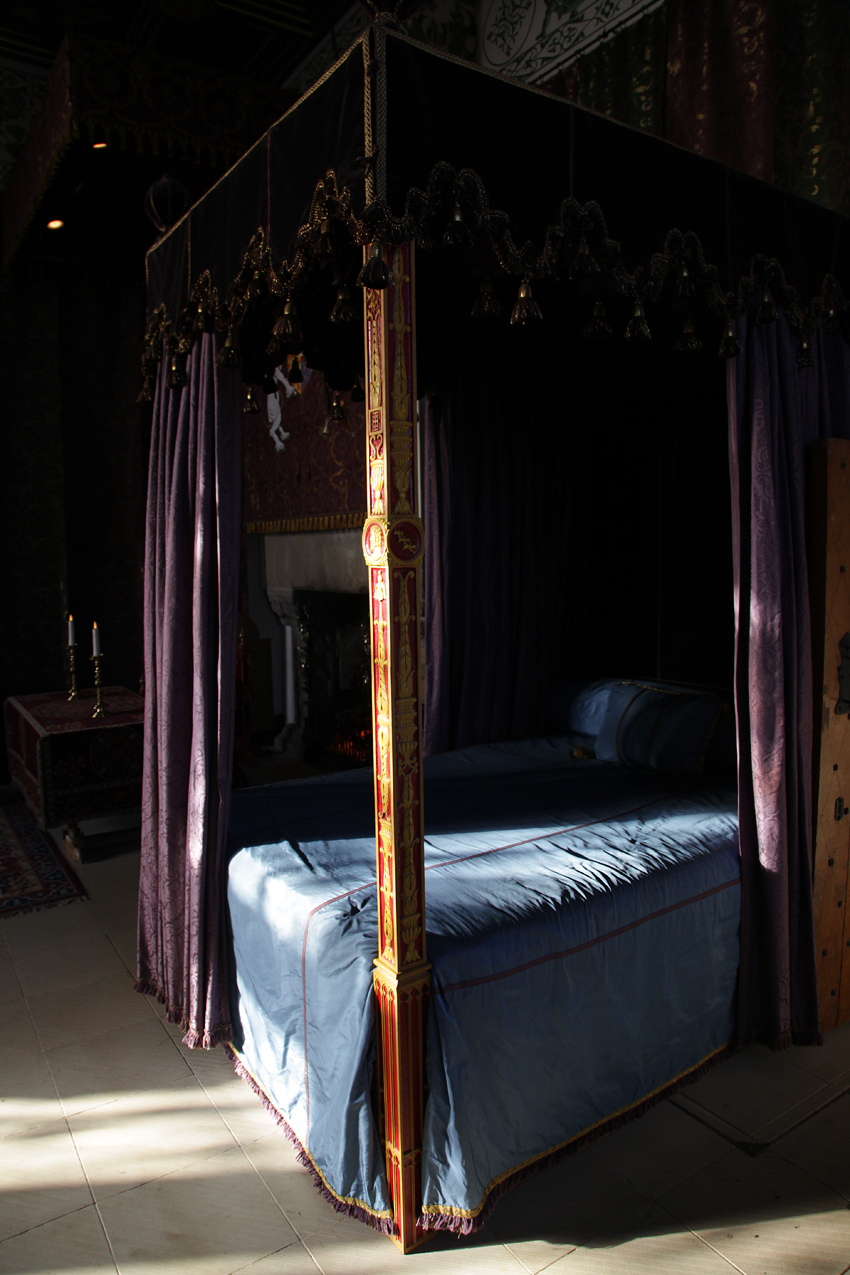 The Queen's bed in the . . . .
The Queen's bed in the . . . .
 Queen's Chamber.
Queen's Chamber.
 The Queen's Chamber was right off the Throne Hall.
The Queen's Chamber was right off the Throne Hall.
 The Throne in the Throne Hall (where else?).
The Throne in the Throne Hall (where else?).
 Sterling Castle Throne.
Sterling Castle Throne.
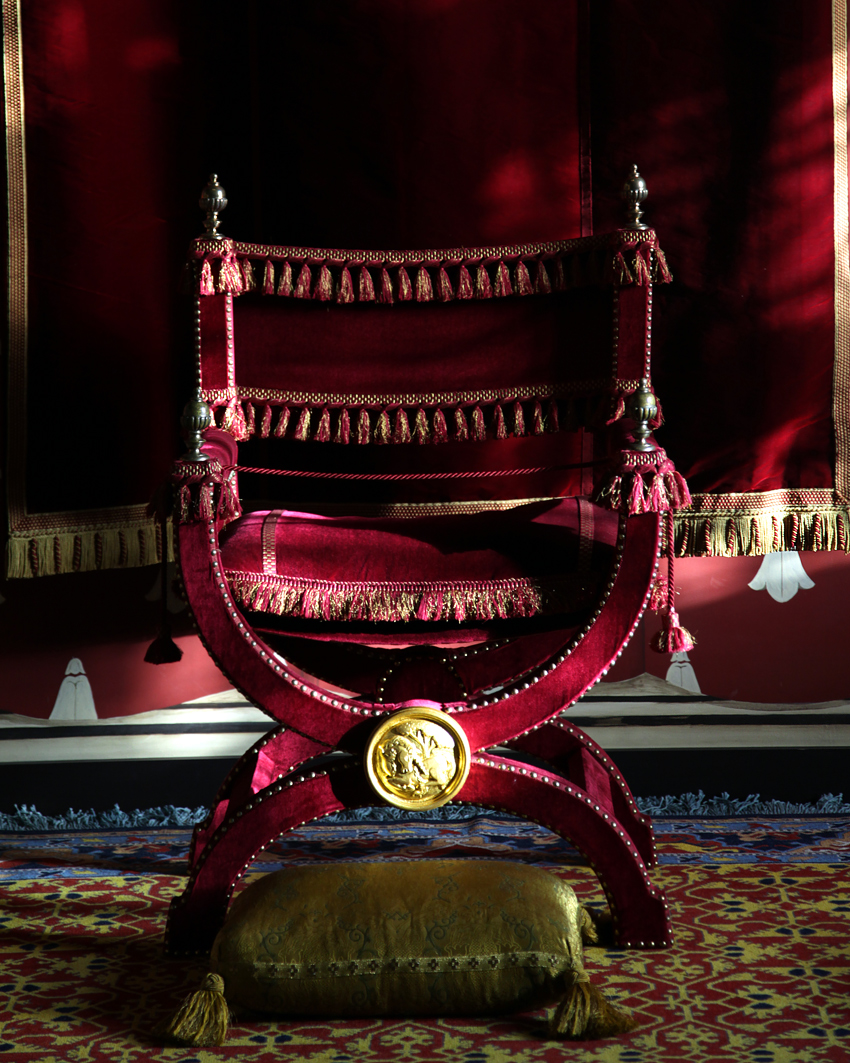 Sterling Castle Throne Chair (SCTC).
Sterling Castle Throne Chair (SCTC).
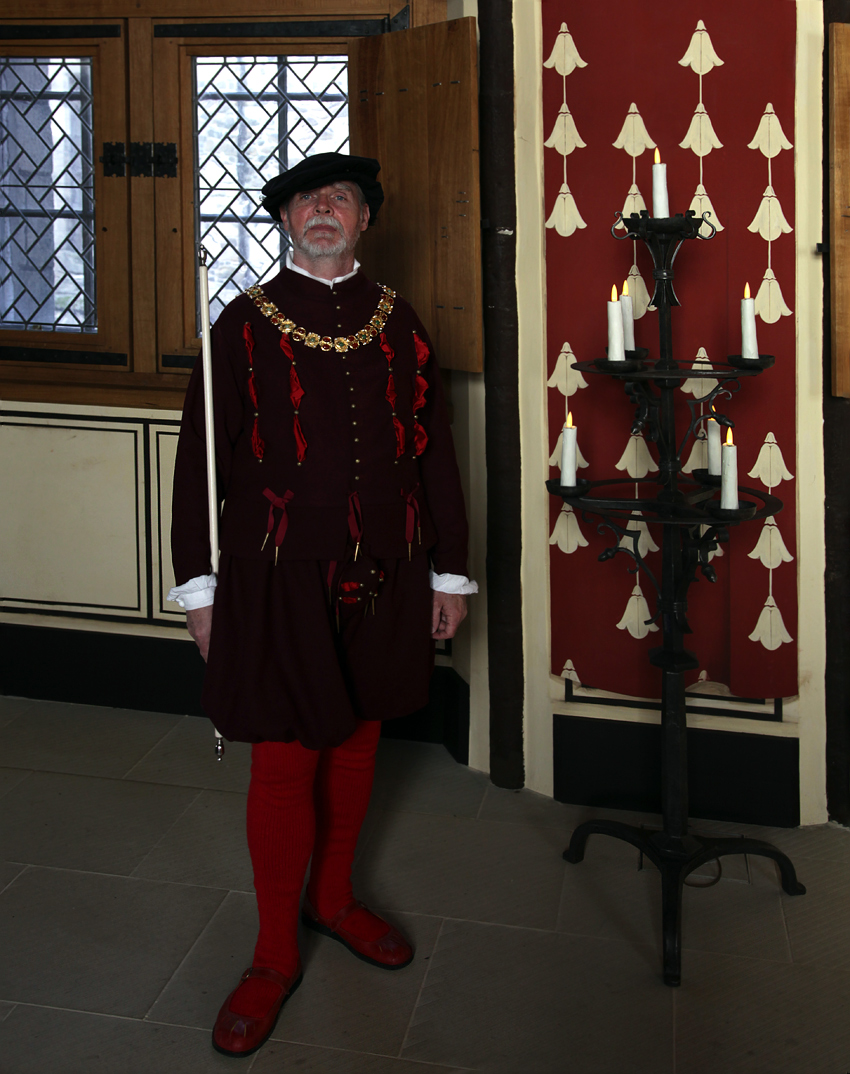 Another Sterling Castle Middle Ages sage actor.
Another Sterling Castle Middle Ages sage actor.
 We left the main castle building for the courtyard . . . where we marveled at the architectural detail. Who designs this stuff?
We left the main castle building for the courtyard . . . where we marveled at the architectural detail. Who designs this stuff?
 The castle chapel was across the courtyard.
The castle chapel was across the courtyard.
 The chapel was a lovely structure.
The chapel was a lovely structure.
 The castle chapel door was a thing of beauty. We opened this door and went inside.
The castle chapel door was a thing of beauty. We opened this door and went inside.
 Tall windows on one side brightly lit the ox blood yellow walls.
Tall windows on one side brightly lit the ox blood yellow walls.
 The chapel interior was austere.
The chapel interior was austere.
 . . . beautiful color, light and shadow in the Sterling Castle Chapel interior.
. . . beautiful color, light and shadow in the Sterling Castle Chapel interior.
 The chapel abuts another throne room. This particular plastered and painted structure was left as is to demonstrate how the entire castle was finished at one time. Later Kings and Queens favored the bare stone.
The chapel abuts another throne room. This particular plastered and painted structure was left as is to demonstrate how the entire castle was finished at one time. Later Kings and Queens favored the bare stone.
 Gargoyles, angles, and saints festooned most of the roofing eves.
Gargoyles, angles, and saints festooned most of the roofing eves.
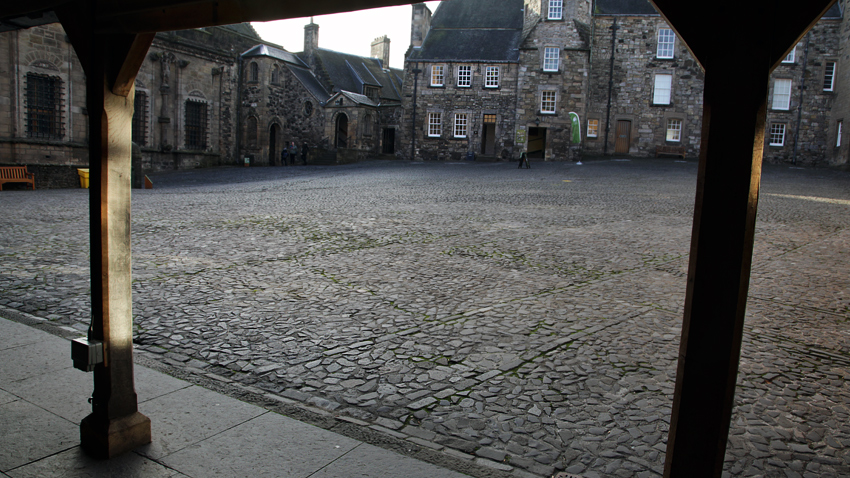 We spent a wonderful morning in Sterling Castle . . . and left through the cobbled central courtyard.
We spent a wonderful morning in Sterling Castle . . . and left through the cobbled central courtyard.
 Cannon emplacements still ring the castle (and were next to the gift shop!).
Cannon emplacements still ring the castle (and were next to the gift shop!).
 I would not want to be on the other end of one of these . . . .
I would not want to be on the other end of one of these . . . .
 Robert The Bruce defeated the British in 1307 and is celebrated in Scotland.
Robert The Bruce defeated the British in 1307 and is celebrated in Scotland.
 As is always the case in the UK, there are monuments to fallen soldiers of past wars.
As is always the case in the UK, there are monuments to fallen soldiers of past wars.
 We passed by the Wallace Monument on our way out of Sterling . . . at Sterling Bridge.
We passed by the Wallace Monument on our way out of Sterling . . . at Sterling Bridge.
 We did not climb up to the Wallace Monument (folly).
We did not climb up to the Wallace Monument (folly).
 We were sorry to have to leave Sterling. The weather had been very cold (2c), but the sky was brilliant, and the clouds were constantly giving us a beautiful vision. Our drive back to Aberdeen took us on the small country lanes and was rather uneventful . . . until we realized we were almost out of fuel! We found a Shell station with only vapors in the tank!
We were sorry to have to leave Sterling. The weather had been very cold (2c), but the sky was brilliant, and the clouds were constantly giving us a beautiful vision. Our drive back to Aberdeen took us on the small country lanes and was rather uneventful . . . until we realized we were almost out of fuel! We found a Shell station with only vapors in the tank!
A Sunday Drive: Cruden Bay and Peterhead
 Saturday, November 16, 2013 at 1:22AM
Saturday, November 16, 2013 at 1:22AM  After breakfast I was getting ready to plug in the iron and de-wrinkle some shirts for work . . . . until I looked out the window. It was a beautiful day, and there is no telling how many more of these we will have here in the far northeast of Scotland.
After breakfast I was getting ready to plug in the iron and de-wrinkle some shirts for work . . . . until I looked out the window. It was a beautiful day, and there is no telling how many more of these we will have here in the far northeast of Scotland.
 "Honey, let's go on a Sunday drive." I called to my wonderful wife.
"Honey, let's go on a Sunday drive." I called to my wonderful wife.
 "OK!" came the answer from the kitchen. ""Get ready while I spray the house plants -- let's drive up the coast to Peterhead."
"OK!" came the answer from the kitchen. ""Get ready while I spray the house plants -- let's drive up the coast to Peterhead."
 And off we went down the small country roads north to Peterhead.
And off we went down the small country roads north to Peterhead.
 The days are short now so the sun is always at a low angle . . . perfect for photography.
The days are short now so the sun is always at a low angle . . . perfect for photography.
 The light was magnificent, the sky was magnificent, and the road was inviting.
The light was magnificent, the sky was magnificent, and the road was inviting.
 Although we had the GPS turned on and set for Peterhead, we turned whenever we saw an interesting sign. Sometimes we stopped to walk around.
Although we had the GPS turned on and set for Peterhead, we turned whenever we saw an interesting sign. Sometimes we stopped to walk around.
 I do love cold and clear days. The Aberdeenshire countryside is fantastic.
I do love cold and clear days. The Aberdeenshire countryside is fantastic.
 Cruden Bay had a nice beach and what looked like an excellent golf course. We vowed to return.
Cruden Bay had a nice beach and what looked like an excellent golf course. We vowed to return.
 Then we arrived in Peterhead, The Blue Toon. It was somewhat vacant and not all that inviting looking. It is a "blue collar" town of fishermen and packing house workers. We parked and walked around to find a restaurant.
Then we arrived in Peterhead, The Blue Toon. It was somewhat vacant and not all that inviting looking. It is a "blue collar" town of fishermen and packing house workers. We parked and walked around to find a restaurant.
 There was a walking street, but no walkers.
There was a walking street, but no walkers.
 Although Peterhead did not look inviting, it actually was. We stopped a woman and asked her where there was a good place to eat. She gladly recommend the Cottonwood. We went there and the service was friendly, the food was good, and the customers were positive and lively. We took the big road home in the dark. It was a nice Sunday.
Although Peterhead did not look inviting, it actually was. We stopped a woman and asked her where there was a good place to eat. She gladly recommend the Cottonwood. We went there and the service was friendly, the food was good, and the customers were positive and lively. We took the big road home in the dark. It was a nice Sunday.